|
by
Richard Lunsford (& the Turtle Forum membership)
Hello & welcome to our concise guide to
browsing Exotic (non-U.S.A. native) turtles! We cover the most common, popular &
highest-interest exotic species by level of overall difficulty to help you pick
a pet & prepare for it. This is a browsing article, not a care sheet or in-depth
analysis (for in-depth help choosing a good ‘starter’ turtle, read our article
on
Choosing Your First Turtle (we also have
Choosing Your First Land-based Turtle)). Be warned exotics are often harder
to find, more expensive & require special conditions (such as tropicals lacking
the ability to hibernate, mandating at least winter-time indoor keeping) than
native U.S.A. turtles. Therefore, don't directly compare our difficulty rankings
for exotics with rankings for U.S. species in our ATP Guide to North American
Turtles as Pets (i.e.: European Pond Turtles & RES have similar size, care &
medium rankings in their respective articles, but the EPT is harder to find &
more expensive). Exotic-keeping is on a whole other level than U.S. temperate
species, so they're held to a lower standard when we decide what's 'easy' or
'hard.'
Important
Factors to consider assessing Difficulty Level:
-
Hardiness - Hardy turtles (i.e.: African Helmeted Turtles, Golden
Thread Turtles) are easier to keep than delicate (i.e.: Argentine snake-necks).
-
Size - Smaller turtles (red-cheeked mud turtles, some
Reeves Turtles) are easier to spaciously house indoors than medium/large
(Indonesian snake-necks) or huge (some Asian softshells like the Chitra
species) species. Caveat: small species mean smaller hatchlings which may
be frailer than larger ones (RES).
-
Environmental Needs - Turtles who can handle simple,
deep-water aquarium setups (red-bellied short-necks) are easier than those
needing palludarium-style (red-cheeked muds) or large mixed environments
(Central American Ornate Wood Turtles). Turtles spending a lot of time on land
challenge you to consider substrate, humidity & air temp.s more so than
aquatics do.
-
Cost - Inexpensive turtles (Reeves, African Helmetted) are
easier to get than moderately expensive (Argentine snake-neck) or expensive
(Indian Spotted Pond, Fly River Turtles).
-
Ease of Acquisition – Commonly available (Reeves) are more
desirable than rare (Indian Spotted Pond) for beginners. Legal protections like
CITES & the Endangered Species Act also complicate acquisition (some species
are practically 'state-locked').
-
Community-compatibility – Turtles who often do well in
mixed setups (Chinese Golden-Thread) are preferable to those needing solo-enclosures (Fly River
Turtles).
-
Nutrition – generalist omnivores & carnivores accepting
pelleted foods are a better match for the diets keepers offer than strict
herbivores or those who demand live foods (some Mata Matas, some snake-neck
turtles). Turtles who demand a high-fish diet may be at risk for
thiaminase-induced thiamine deficiency &
potentially toxic levels of chemicals used to treat commercial feeders for
parasites.
-
Captive-Bred vs. Imported & the Parasite Issue - Many exotic species are
wild-caught & imported in poor conditions over expended periods (some
redirected from food markets!). Such conditions weaken the animal & may
allow over-proliferation of parasites which can sicken & kill the turtle. We
also don't want exotic parasites proliferating in U.S. captive collections
(i.e.: your RES picking up some Asian hookworm from your Reeve's). Most
imports should be deparasitized with antibiotic regimens. This may be costly
(available to Vet. prescription) & administration to some species quite
difficult.
-
Your Situation – You may have situational advantages or
disadvantages most people don’t. Some parts of the extreme southern U.S. have a
climate allowing year-round outdoor keeping of tropicals in large pens (i.e.:
year-round outdoor keeping of red-foot tortoises is easier in southern Florida
than Wyoming). A big yard in the southwest may simplify Sulcata ownership. An
upper-level apartment with weak floors may not tolerate a huge aquatic setup. A
key issue is that many exotics are tropical & can’t hibernate, or natural
hibernation conditions aren’t well-known. Many U.S. cities produce moderately
hard, alkaline water, making it hard to provide the soft, acidic water desired
for some South American species.
-
Information
– more so than with U.S. native species,
consider how much is known about a given exotic species. The turtle hobby has a
growing body of highly skilled enthusiasts but it’s still harder to get
good information on breeding Spot-bellied side-necks than southern painted
turtles!
-
Breeding - if you have an interest in breeding exotics, you'll want to
know how whether they're prolific (i.e.: multiple large clutches of
eggs/year), breed readily in captivity & are easily accommodated. For
example, the Fly River Turtle is hardly ever bred in captivity because
recreating a naturalistic nesting site is very hard to do (not to mention
how violent they are to each other!).
Provided Information – In the spirit of
light-reading, I’ll provide a brief blurb about each hitting on what’s relevant;
common names are hyper-linked to ATP Care Sheets where available. Description
briefly sums up size (small, medium, large or a range), significant details if
any & type (basking species, bottom walker, terrestrial semi-aquatic (most time
spent on land), aquatic semi-terrestrial (most time spend in water),
terrestrial). Pro.s lists prime selling points of the species, & Con.s
problems with it. Cost is just for the turtle; from online vendors add about
$20-25 overnight shipping (for the whole order), & for expo.s add roughly $5-10
entrance fee.
Section I
– The Best Starter Turtles.
Small, fairly hardy, affordable, readily
available, simple enclosure needs. Can be kept in tanks minimum 29
gallons (55 for some) & should prosper in 75 gallon+.
1.)
Red-Cheeked Mud Turtle
-
Kinosternon
scorpioides
cruentatum
(1 of 4 subspecies of the Scorpion Mud Turtle)
Description: Standard moderately-domed 'mud turtle' form with a plain
dark-brown carapace, similar to an Eastern mud, but the sides of the head/face
are an ornate orange to red. Plastron (plain yellowish) can close completely if
turtle not obese. Predominantly carnivorous. Recommend at least 75 gallon 'palludarium-style'
tank with more water than land. Native range from southern Mexico into El
Salvador, Guatemala & Honduras. Size: (Males are larger) Typically
5-6", but up to 7" SCL.
Pro.s: Strikingly beautiful due to the rich orange/red face/head
coloration. Quite small, & much smaller than a white-throat mud. Well-developed
plastron provides some protection on land. Fairly prolific (small turtle species
tend to have small clutch sizes).
Con.s: Palludarium-style setups with more (shallow) water than land
aren't compatible with some other species you may want. Not a hibernator.
Availability & Cost: Somewhat common at online vendors. Hatchlings ~ $30 apiece. I've seen adults ~ $50
apiece.
Known Legalities: None known in U.S.
Helpful Care Resources:
World Chelonian Trust's
Kinosternon Photo Gallery, Empire of the Turtle's
Red-Cheeked Mud Photo & range page, &
comparison of red-cheeked, white-throat & scorpion muds.
|
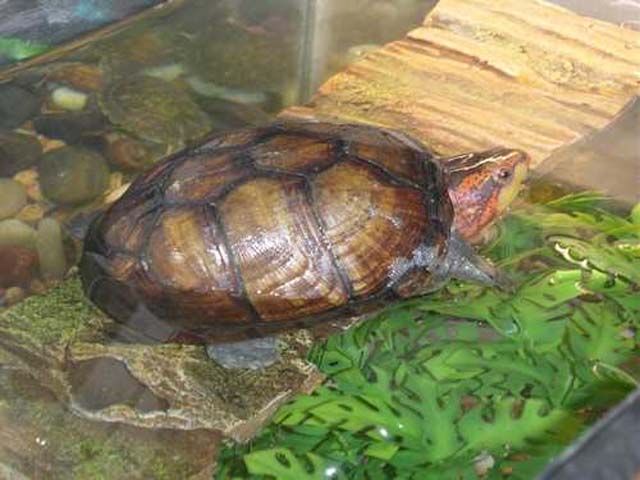 |
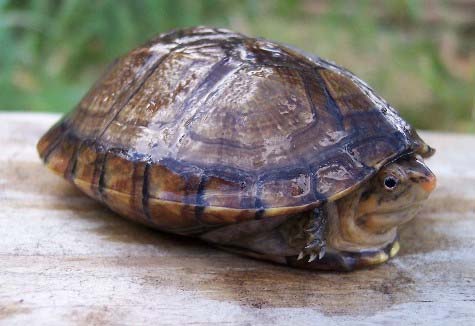 |
|
Photo by Gummylick |
Photo by Turtle Pimp |
2.) Scorpion
Mud Turtle -
Kinosternon scorpioides scorpioides
Description: Small-to-medium moderately domed standard 'mud-turtle'
form-factor with a brown carapace & a plastron that can close
completely if turtle not obese. The sides of the head/face often have orange-to-red coloration
(but less than a red-cheeked mud).
Plain plastron. Predominantly carnivorous. Native to Northern South America. Size: (Males are larger)
Typically ~ 6-7" SCL, but can get considerably larger (close to 12").
Pro.s: Fairly small (smaller than a white-throat mud). Some may have
attractive head/face coloration. Well-developed
plastron provides some protection on land.
Con.s: Considerably larger than a red-cheeked mud or most North American
muds. Head/face coloration less apt to be as ornate as a red-cheeked or
white-throated mud. Mud turtle habitats generally feature fairly shallow water & decent
land-sections, which may preclude keeping other species you're interested in
(i.e.: don't drop one in a Belize slider tank with nothing but deep water & a
basking platform). Not a hibernator.
Availability & Cost: Uncommon in the online pet trade & be warned
this is one of 4 sub-species so intergrades are a possibility. One popular
vendor offers hatchlings for ~ $15 apiece & said importers offer wild-caughts
for ~ $10. Elsewhere I've seen a long-term captive trio (1.2.0) for $120, &
adult wild-caught imports for $18 apiece.
Known Legalities: None known in U.S.
Helpful Care Resources:
World Chelonian Trust's
Kinosternon Photo Gallery,
World Chelonian Trust's
Kinosternon Photo Gallery, Empire of the Turtle's
Scorpion Mud Photo & range page, &
comparison of red-cheeked, white-throat & scorpion muds.
3.) White-lipped
Mud Turtle - Kinosternon
leucostomum (Not a scorpion mud sub-species! There are 2 sub-species
of white-lipped mud)
Description: Small-to-medium moderately domed standard 'mud-turtle'
form-factor with an brown-to-black carapace & a plain plastron that can close
completely if turtle not obese. The sides of the head/face have variably colored blotching/striping/speckling;
tend to be light-colored around the jaw edges. Omnivorous but mainly carnivorous. Native to Central
America - ranges from Mexico to Nicaragua, Columbia, Ecuador & Peru. Size:
Males are larger & can get up to nearly 7" SCL; females up to ~ 6" SCL.
Pro.s: Small. Attractive head/face coloration. Well-developed plastron
provides some protection on land. Can aestivate. Mildly prolific (small turtle
species tend to have small clutch sizes).
Con.s: Some-what larger than a red-cheeked mud or most North American muds.
Appearance quite variable (you can't assume yours will look like one in a
photo). Males may be mutually aggressive39. Mud turtle habitats generally feature fairly shallow water & decent
land-sections (some spend considerable time on land), which may preclude keeping other species you're interested in
(i.e.: don't drop one in a Belize slider tank with nothing but deep water & a
basking platform). Not a hibernator.
Availability & Cost: Fairly common at online vendors. I've seen
young adults at $25 each, 6"+ adults at $35 each, a hatchling for $30, & an unspecified individual for $20.
Known Legalities: None known in U.S.
Helpful Care Resources:
Photos from Costa Rica,
Carapace &
Plastral Views.
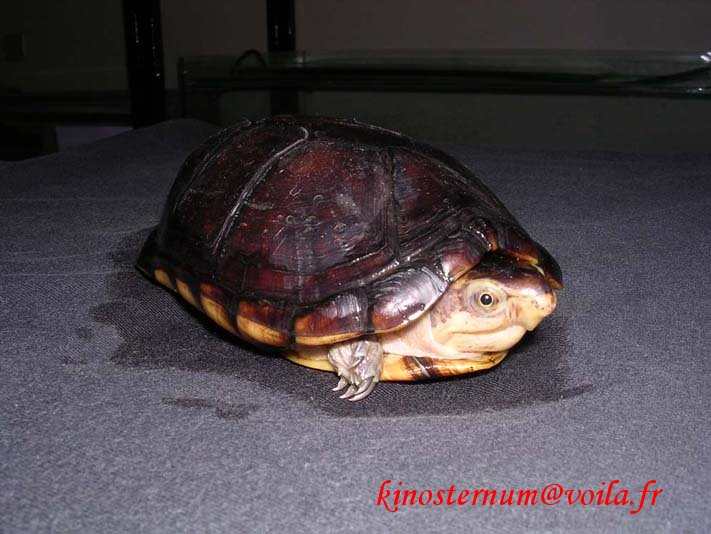 |
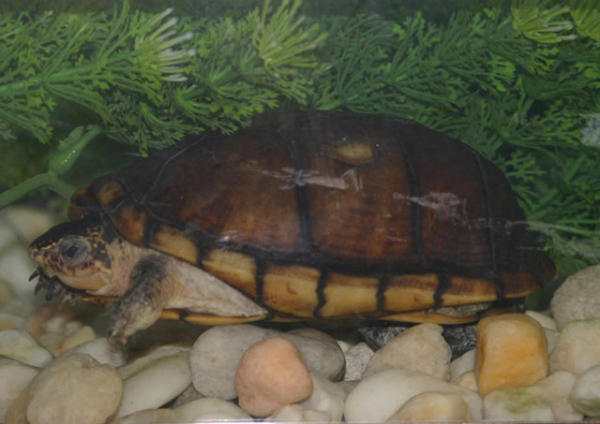 |
|
Photo by Kinosternum |
Photo by Kimberly |
4.)
Reeve's
Turtle
-
Chinemys reevesii
Description: Probably the most recommended starter exotic. Medium-sized
basking aquatic. Reeve's have moderately domed black-to-brown carapaces with 3
length-wise keels, dark
brownish or black plastrons, black skin, a rather 'musk/mud-like' head, whitish
stripes on the side of the head & a strong bar across the eye pupil. Overall,
looks like a cross between a RES & a stinkpot. Care similar to a RES but with
shallower water (up to 10" deep) with resting areas near the surface (like a
stinkpot enclosure on a larger scale) Omnivorous. Recommend at least a 55
gallon tank. Native to China, Korea, Taiwan & Japan. Size: Females to 9"
SCL, but males much smaller (Reeve's actually vary a lot; some stay closer to
5", some get over 9").
Pro.s: Hardy with strong appetites. Reputation for being quite
personable with humans (for a turtle). Can be kept in medium-sized enclosures.
May have some hibernation-capability4 but exposing them to cool water is chancy. Available captive-bred.
Con.s: A couple of forum members report they can 'freeze up' in cool
water & may pose a drowning risk. In Practical Encyclopedia of Keeping &
Breeding Tortoises & Freshwater Turtles (Page 157) Highfield2
states males tend to be mutually aggressive (conspecific aggression) & may require separation.
Zebeck noted male Reeve's may also be aggressive toward other species (interspecific
aggression). Some
hatchlings don't swim well so use shallow water.4 Some are imports & those should get deparasitization.
Availability & Cost: Common for an exotic. Hatchlings ~ $25-50.
Known Legalities: None known in U.S. It's CITES III in China.
Helpful Care Resources:
Asian
Turtle Consortium/World Chelonian Trust Care Sheet,
California Turtle &
Tortoise Club Care Sheet,
David Kirkpatrick's
Care Sheet,
World
Chelonian Trust Photo Gallery.
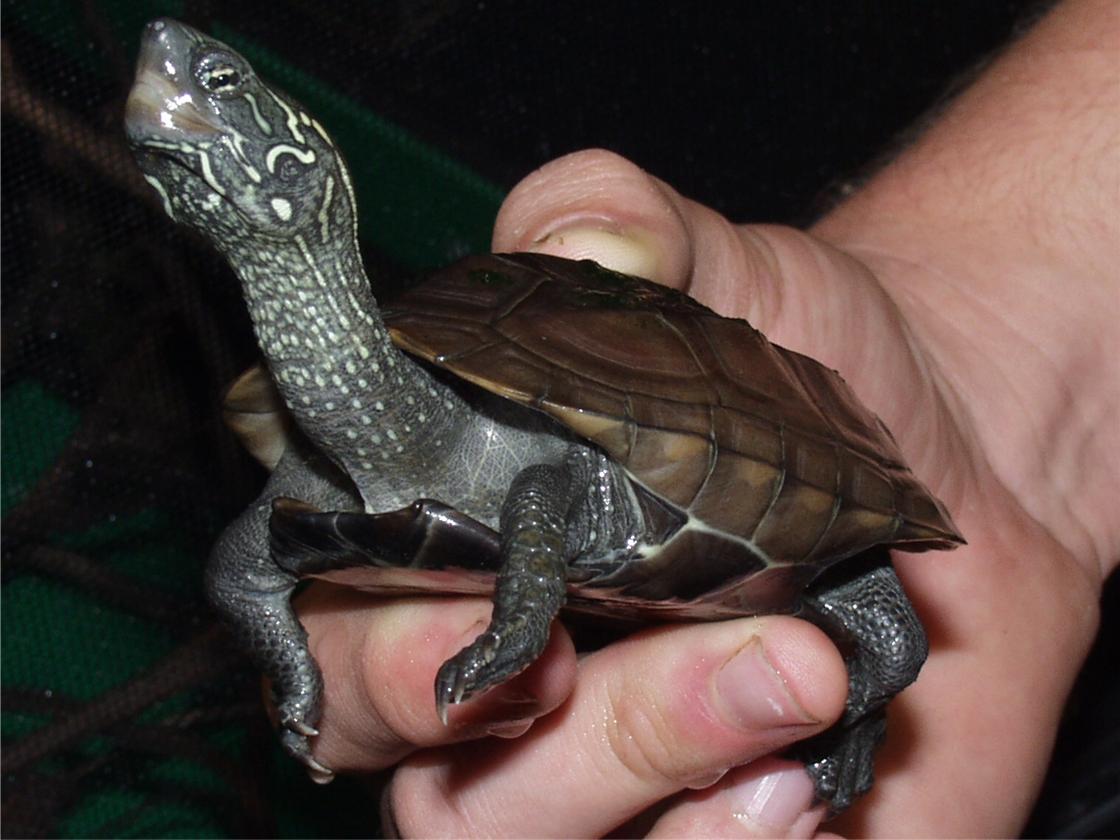 |
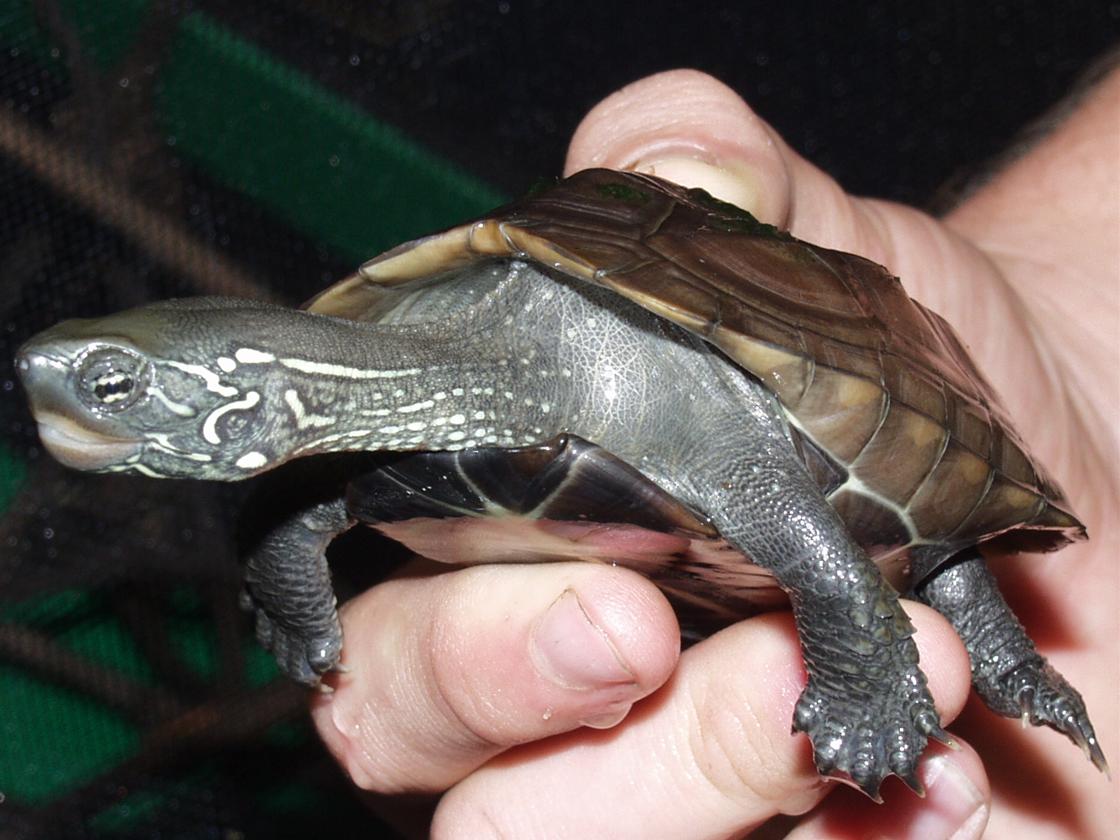 |
|
Photo by Richard Lunsford |
Photo by Richard Lunsford |
Section II – Second Choice Starter Turtles.
Per Section I but with one or more moderate
drawbacks, such as being problem-prone if water quality isn’t high, delicacy as
hatchlings or rarity & cost.
1.) White-Throated Mud Turtle
-
Kinosternon
scorpioides
albogulare
(1 of 4 subspecies of the Scorpion Mud Turtle)
Description: Medium-sized moderately domed standard 'mud-turtle'
form-factor with an olive-to-brown carapace & a plastron that can close
completely if turtle not obese & is ornate on hatchlings but often plain in
adults. The sides of the head/face often have orange-to-red coloration (but less
than a red-cheeked mud).
Predominantly carnivorous. Native to Central Central America - ranges from
Honduras to Panama. Size: (Males are larger) ~ 7-8" SCL.
Pro.s: Medium-sized. Striking head/face coloration. Well-developed
plastron provides some protection on land.
Con.s: Considerably larger than a red-cheeked mud or most North American
muds (bulky, too). Mud turtle habitats generally feature fairly shallow water & decent
land-sections, which may preclude keeping other species you're interested in
(i.e.: don't drop one in a Belize slider tank with nothing but deep water & a
basking platform). Not a hibernator.
Availability & Cost: Fairly common at online vendors; one popular
vendor offers hatchlings for ~ $17, & said importers charge around $10 for wild-caughts.
Known Legalities: None known in U.S.
Helpful Care Resources:
World Chelonian Trust's
Kinosternon Photo Gallery, Empire of the Turtle's
White-Throated Mud Photo & range page, &
comparison of red-cheeked, white-throat & scorpion muds.
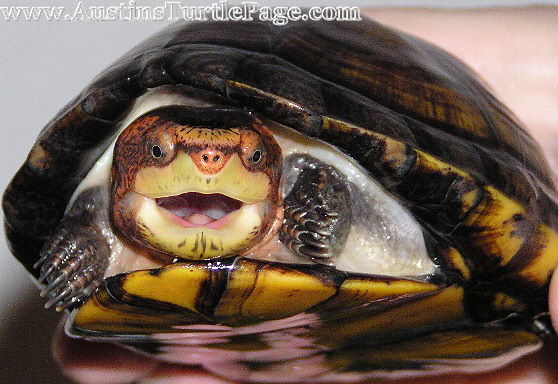 |
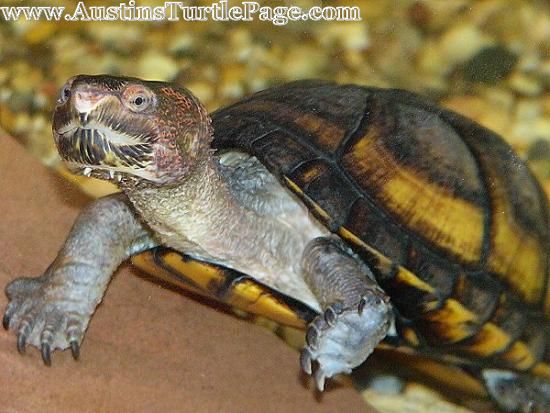 |
|
Photo by Tom C. |
Photo by Tom C. |
2.)
European Pond Turtle -
Emys orbicularis
orbicularis
(13 sub-species)
Description:
Medium-sized basking aquatic species similar in size, general form & care to
red-eared sliders. The have a brown-to-black carapace & skin with a multitude of tiny
yellow specks like a Blanding's Turtle (but no bold yellow lower jaw).
Omnivorous leaning toward carnivory. Recommend minimum enclosure 75 gallon tank. Native to much of Europe
& the Middle East. Size: Up to 8" SCL.
Pro.s:
Hardy & cold-tolerant as exotics go. Reputedly intelligent (for a turtle). Care same as RES, which is well-known &
straight forward. Can 'strike & suck' to catch prey (including fish). Hibernate in their native range.
Con.s:
Some are resistant to eating commercials pellets at first.
Tom C. had 3 in a tank beside a similar tank with 2 RES, & the EPT's tank was
much more prone to be filthy for unknown reasons. Many are wild-caught imports &
should be deparasitized.
Availability & Cost:
Somewhat uncommon in the hobby but can be found. Hatchlings ~ $50.
Known Legalities:
None known in U.S.
Helpful Care Resources:
California Turtle &
Tortoise Club's Care Sheet,
World Chelonian
Trust's Photo Gallery.
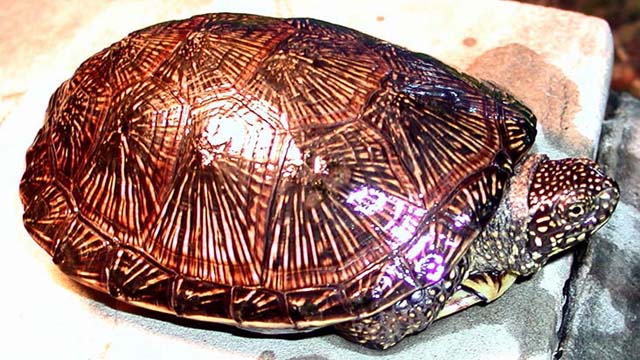 |
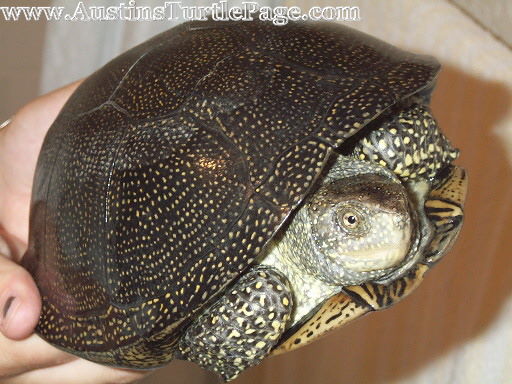 |
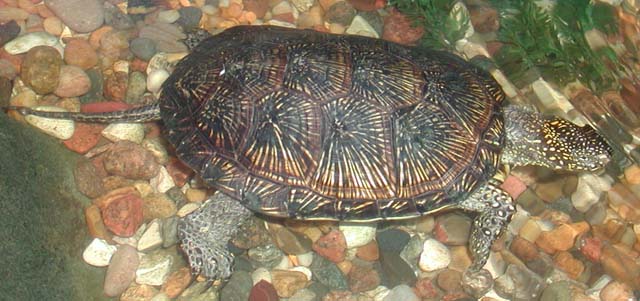 |
Left-hand pics (Top & Bottom) -
Dr. Noll
Right-hand top pic - Tom C. |
3.)
Chinese Golden Thread (a.k.a. Stripe-neck) Turtle
-
Ocadia sinensis
Description: Medium-sized basking aquatic species similar in size,
general form & care to red-eared sliders. Carapace has a brownish
(sometimes greenish) base with
3 broken orangish stripes. Head strongly striped except dark triangle on
top. Bar through eye pupil. Tails fairly long in adults & quite long in
hatchlings. Omnivorous, with more carnivory in juveniles & more herbivory in
adults. Recommend minimum 55 gallon aquarium for a male, 75 for a female.
Size: Males 6 - 8", Females up to 10".
Pro.s: Most everything modeled on slider care (so easy for hobbyists
to transition to) with a distinctive exotic & fairly ornate look. Fairly
cold-hardy. Not as aggressive as RES. Hardy &
fairly prolific. Can be had captive-bred. Fairly likely to get along with
other turtles & even fish (not great at catching fish).
Con.s: Large & active enough to need a decent-sized enclosure.
Despite RES-like care may not swim quite as well so allow for underwater
'furniture' to rest on. Older individuals often much plainer in coloration. Don't try hibernating in captivity10. Some are
wild-caught & should be deparasitized.
Availability & Cost:
Fairly common at online vendors. Hatchlings ~ $25 - $50.
Known Legalities:
None known in U.S. CITES III in China.
Helpful Care Resources:
ATP Care Sheet,
World Chelonian
Trust's Care Sheet,
Turtlepuddle's
Care Sheet.
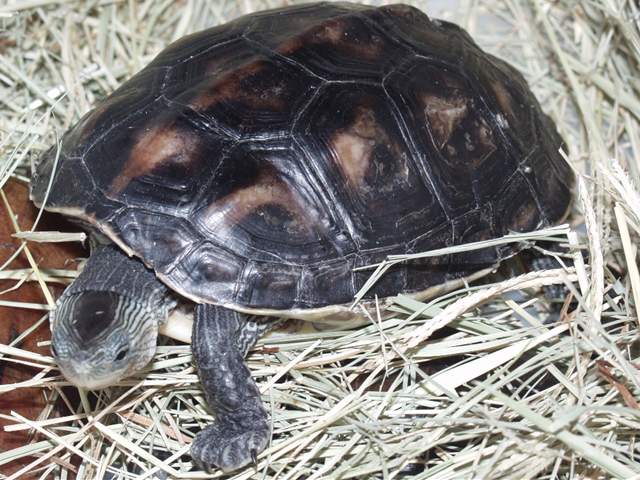 |
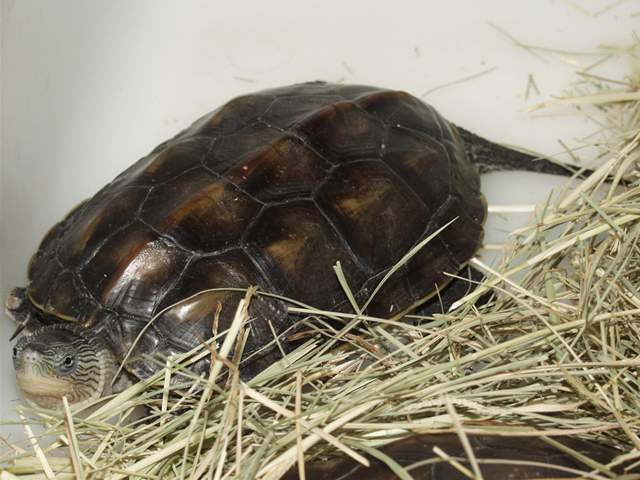 |
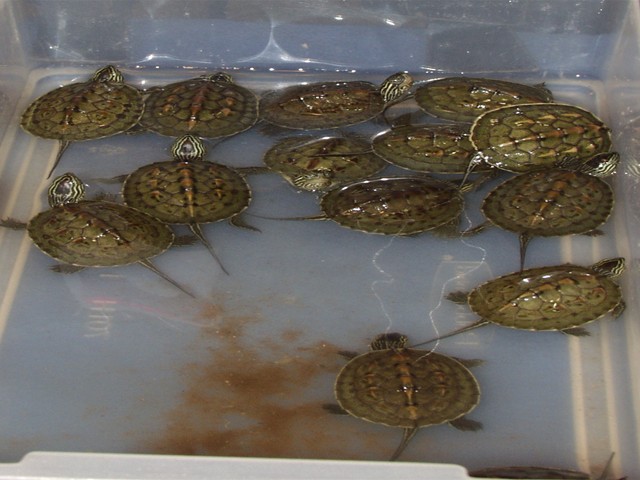 |
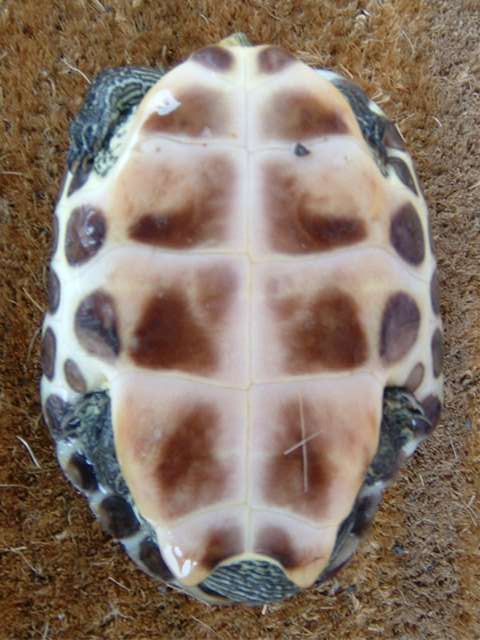 |
|
Top Left & Right - Adults for sale at Daytona
Captive Reptile Breeders' Expo. '04.
Bottom Left - Group of hatchlings for sale at
the same expo.
Photos by Richard Lunsford
|
Bottom Right - Adult Plastron View - Photo
by J.J. |
4.) African Helmetted Turtle
- Pelomedusa subrufa
(2 sub-species).
Description: Moderately-domed medium-sized basking side-necked aquatics
with a plain brown to grey carapace, long neck & oddly expressive, almost smiling face -
imagine a male RES-sized yellow mud turtle with a long neck & you've got it.
Omnivorous but largely carnivorous. Recommend at least a 55 gallon tank for one.
Given their 'bottom-walker' build, provide means of resting near the surface if
desired, & insure they can get air without having to swim in at least part of
the tank. Native to Africa & Madagascar (including seasonal ponds, lakes &
watering holes, & can aestivate under mud & in part of their range hibernate per
Practical Encyclopedia of Keeping & Breeding Tortoises & Freshwater Turtles
(Page 216) Highfield2). Size: Up to 8" SCL.
Pro.s: Hardy. Medium-sized. Inexpensive for an exotic. Prolific
breeders. Captive-bred available.
Con.s: Can be aggressive. The related
genus Pelusios has turtles who grow larger (be careful what you get!).
In Practical Encyclopedia of Keeping & Breeding Tortoises & Freshwater
Turtles (Page 216) Highfield2 states they're an aggressive
species. While somewhat cold-hardy when exposed to extended cold, Russ Gurley (Keeping and
Breeding Freshwater Turtles Page195) notes
they're prone to respiratory problems1 (so I don't recommend hibernating
them). Some are imported & need deparasitization.
Availability & Cost: Fairly common as exotics go. May turn up at pet
stores & expo.s. I've seen wild-caught juveniles that haven't been
deparasitized for $16 apiece.
Known Legalities: None known in U.S. CITES III in Ghana.
Helpful Care Resources:
Yahoo! Discussion Group on
genus Pelusios (17 species),
Turtles of the World CD
Sample Entry on Pelomedusa subrufa3,
World Chelonian Trust's
Photo Gallery.
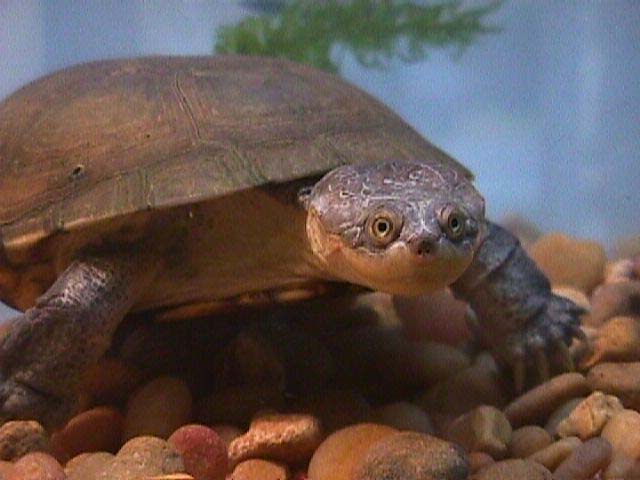 |
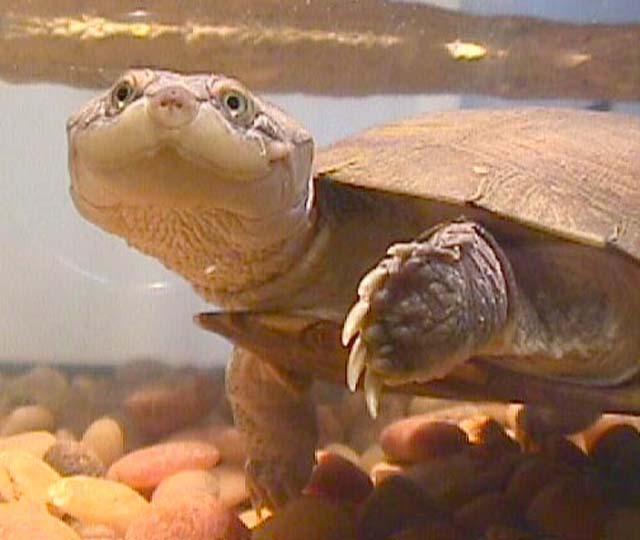 |
|
Photo by Erika Pike |
Photo by Erika Pike |
Section III – Medium-Level Turtles.
Medium-sized & need larger enclosures or
otherwise demand more expensive &/or specialized enclosures.
1.)
Black-Breasted Leaf Turtle
-
Geoemyda spengleri
Description: Small largely terrestrial turtle (yet in nature occurs near
cool-water streams) with a yellowish-brown
keeled carapace (with lengthwise ridges, & thorn-like spikes at the posterior
carapace rim), striped neck & striking eyes with clear irises & no bar across
the pupil. In males the skin on the front legs & neck is reddish/orangish. Fairly secretive.
They do bask. Recommend at least a 20 gallon long tank, ideally palludarium-style
but more land than water, humid & a bit cool. Carnivorous. Native to forest floors in Southern China
& Viet Nam. Size: Up to 6" SCL (but usually smaller).
Pro.s: Beautifully ornate & exotic looking. Small size & limited
activity allow small enclosures. Vigorously pursue prey. Captive-bred are
available & strongly advised over wild-caught! Captive-breds (or deparasitized
wild-caughts) in proper conditions should prosper.
Con.s: Prone to die in captivity if specific care needs aren't met (very
unforgiving of bad care)8. Mainly terrestrial palludarium-style setups aren't amenable to
adding other species. Terrestrial substrate setup & maintenance & keeping
shallow water clean can be a hassle. Secretive & may hide a lot. May overeat
themselves into an early grave if you aren't careful. May not accept dry
commercial foods8. Females a bit drabber. Territorial so plan a large
enclosure if you keep > 19. Uncommon in the trade &
rather expensive. Imports should be deparasitized. Not very prolific.
Availability & Cost: Uncommon in the pet trade but can be found if
you're persistent. A young juvenile at Daytona Captive Reptile Breeders' Expo.
'04 was priced at $225.
Known Legalities: None known in U.S. CITES III in China.
Helpful Care Resources:
Asian
Consortium's & World Chelonian Trust's Care Sheet Pair,
James Buskirk's Care Sheet,
World Chelonian Trust's
Photo Gallery.
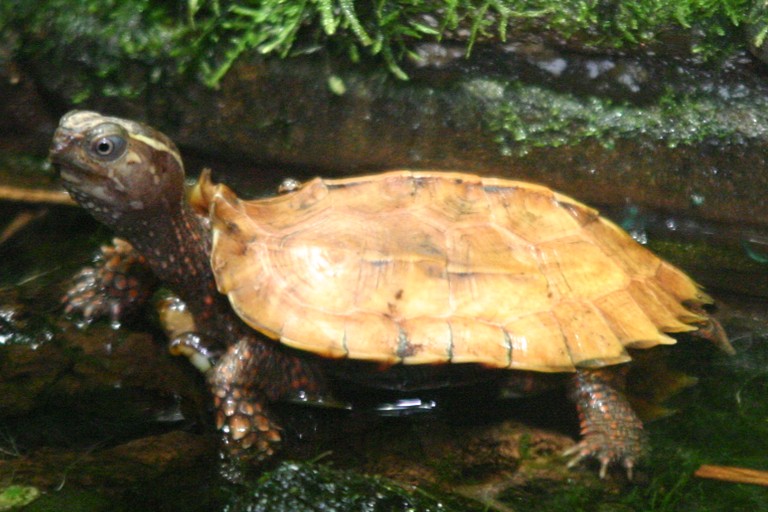 |
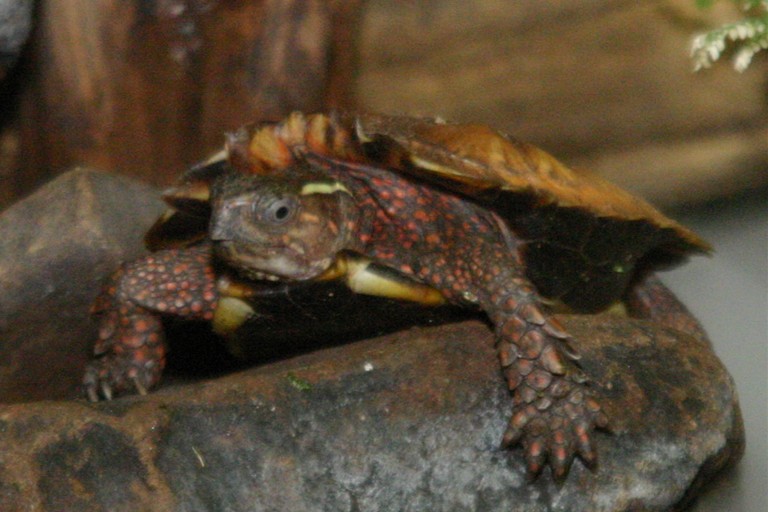 |
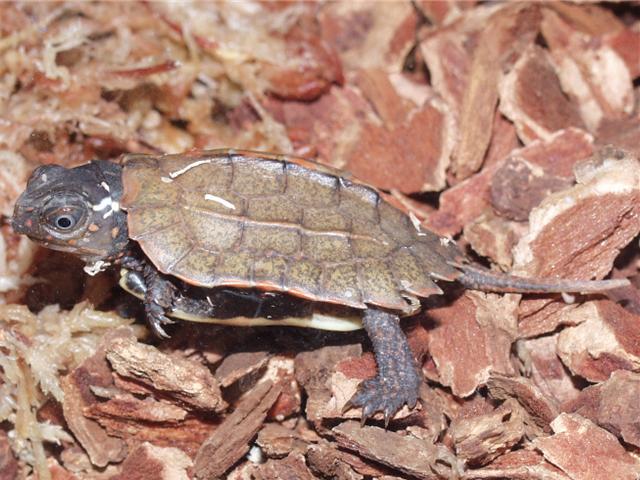 |
Top left & right are adults.
Left bottom is a young juvenile.
All 3 Photos by Richard Lunsford |
2.)
Caspian Creek turtle (a.k.a. Caspian Pond Turtle) - Mauremys caspica
(4 subspecies)
Description: A small-medium brown basking aquatic turtle with slightly oblong carapace and cream
to grey/black colored plastron with brown to red blotches; often dull and
overall unremarkable. Stripes on neck and legs vary in color from subdued creams to very bright yellow
and orange. Some specimens quite striking as a result. A subtle dorsal keel
divides the carapace. General care like sliders. Omnivorous. Recommended
Enclosure at least a 55 gallon tank. Native to the Eastern Mediterranean
(including southwestern former USSR & part of the Middle East, Turkey,
Bulgaria & former Yugoslavia). Size: Adult males 4.5 - 7 inches, females 5 - 9
inches.
Pro.s: Exceptionally good feeder, wild-caught adults take pellets readily
and at all stages of life many foods, plant and animal, are readily taken.
Extremely heat and cold tolerant (though this may vary with origin of geographic
location) have seen them active at 5º C and at 44º C!
Fairly prolific.
Con.s: Often very secretive and shy at first, eventually more personable.
May want to aestivate/hibernate if kept outdoors and difficulty with locality
information may make this hard to predict. Males may be highly mutually
aggressive and stake out territories. (spacious enclosures or one male per
enclosure recommended). Often difficult to distinguish from Mediterranean Pond
Turtle (Mauremys leprosa) and Caspian River Turtle (Mauremys rivulata).
Availability & Cost: Highly variable. Few breeders in US (many in Europe)
& imports are erratic. Wild-caught adults ~ $12 - 50, Captive-bred hatchlings ~
$50 - 125.
Known Legalities: None known for U.S.
Helpful Care Resources:
Mauremys Turtles of The Mediterrean at Tortoise Trust,
Empire
of the Turtle's Info. & Photos,
World Chelonian
Trust's Mauremys Gallery.
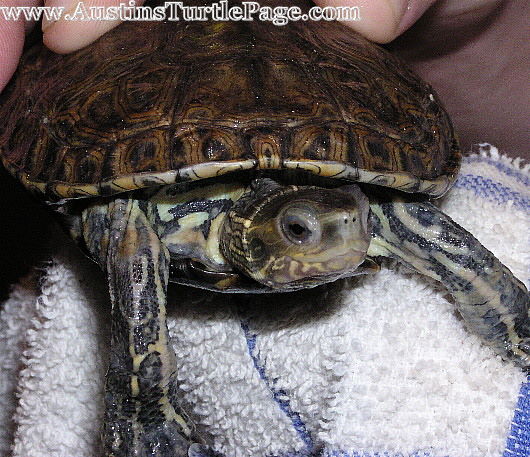 |
|
M. caspica caspica - Photo by Tom C. |
3.)
Japanese Pond Turtle
-
Mauremys japonica
Description: Medium-sized basking semi-aquatics with a RES-like overall
form but they're less strictly aquatic & do spend time on land. Drab brown. Hatchlings have really long tails (like North American Wood
Turtles). Omnivorous. May like somewhat cool temps. Recommend at least a 75
gallon tank. Native to Japan. Size: Females up to 7 or 8" SCL, but males
smaller.
Pro.s: Handsome in drab sort of way. Stay fairly small for an exotic.
Hardy. Can be bred & are prolific.
Con.s: Drab coloration. Should have a land section (not just a small
basking platform) & Zebeck noted they prefer a substrate they can burrow in.
Availability & Cost: Uncommon in the trade but can be found with
persistence. Hatchlings ~ $65 - 75. I've seen 2" SCL offered for ~ $100.
Known Legalities: None known in U.S.
Helpful Care Resources:
TurtlePuddle's Care
Sheet,
World
Chelonian Trust's Mauremys Gallery.
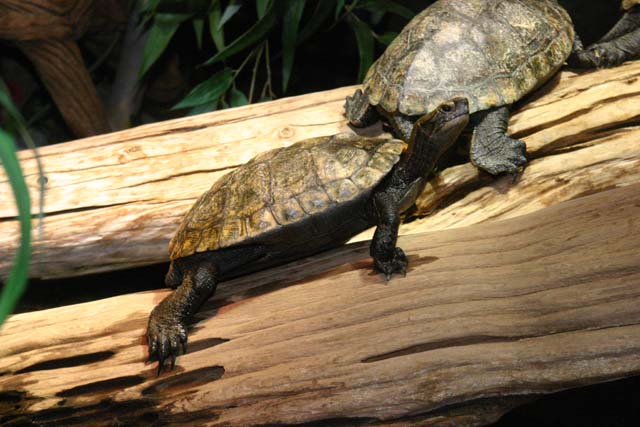 |
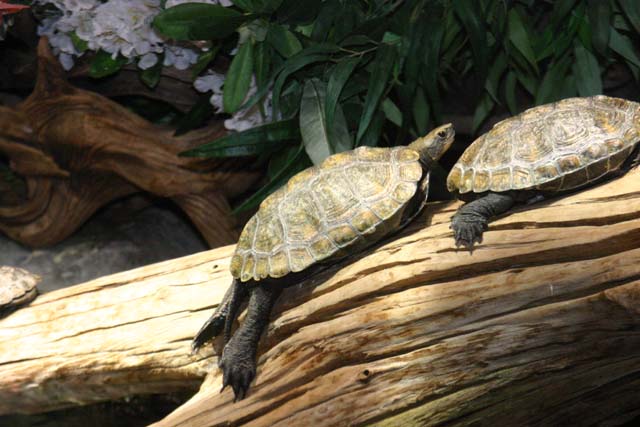 |
|
Photo by Richard Lunsford |
Photo by Richard Lunsford |
4.)
Kwangtung River Turtle -
Chinemys nigricans
Description: Medium-sized basking aquatic with moderately domed
black-to-brown carapaces, red plastrons, black skin, a rather mud-like' head, whitish stripes
on the side of the head. Overall, looks like a Reeve's but darker overall, less
head striping & darker eyes. Care similar to a RES but with shallower water (up
to 10" deep) with resting areas near the surface (like a stinkpot enclosure on a
larger scale) Omnivorous. Recommend at least a 75 gallon tank. Native to a
small range in southeastern China & northern Vietnam. Size: Females to
12" SCL, but males much smaller.
Pro.s: Hardy. The genus has a reputation for docility & intelligence.
Can be kept in medium-sized enclosures. Available captive-bred.
Con.s: Darker eyes, less ornate head/neck striping, less availability &
greater cost make them less desirable than Reeve's for many. Don't over-feed!
Hatchlings may be poor swimmers so offer shallow water per
Darrell Senneke7.
Inter-male aggression common in Reeve's might apply to these, too. Imports
should be deparasitized.
Availability & Cost: Hatchlings ~ $75-100.
Known Legalities: None known in U.S. CITES III in China.
Helpful Care Resources:
World
Chelonian Trust/Asian Turtle Consortium Care Sheet,
World Chelonian Trust
Photo Gallery.
5.)
Red-bellied Short-neck
-
Emydura subglobosa (a.k.a. Pink-bellied
Short-neck)
Description:
Standard slider forum-factor only the carapace is grey to black, the
plastron yellowish with reddish trim, & the head dark with a yellow stripe
behind & over the eye. Care like a slider except warmer water. Basking
varies amongst individuals & some seldom do but the option should be there. Omnivorous. Native to Australia
& New Guinea. Recommend at least a 75 gallon tank. Size: Up to 10" SCL.
Pro.s: Quite attractive. Hardy but need warm water. Similar form & care
to the familiar RES. Captive-bred readily available. Prolific.
Con.s: Tropical - do not hibernate. Gurley1 noted males tend
to be aggressive to unreceptive females & smaller turtles. In Practical
Encyclopedia of Keeping & Breeding Tortoises & Freshwater Turtles (Page
168) Highfield2 states the genus is susceptible to skin & shell
infections if subjected to poor water quality. Turtle Pimp reported prone to
skin fungus if they don't bask enough. Imports should be deparasitized.
Availability & Cost: Common at online vendors & larger expo.s.
Hatchings ~ $50.
Known Legalities: None known in U.S.
Helpful Care Resources:
ATP Care
Sheet,
California Turtle & Tortoise Club Care Sheet,
TurtlePuddle's Care Sheet,
World Chelonian
Trust's Photo Gallery.
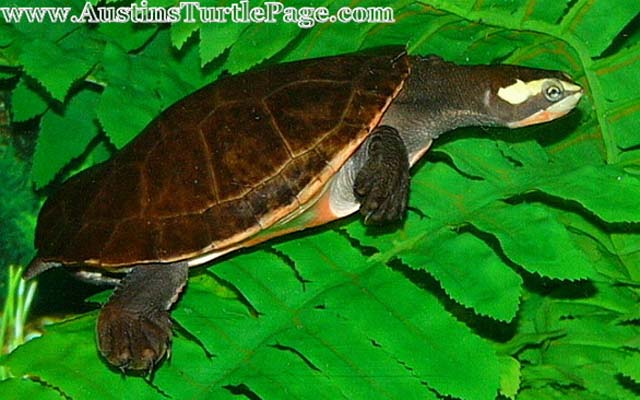 |
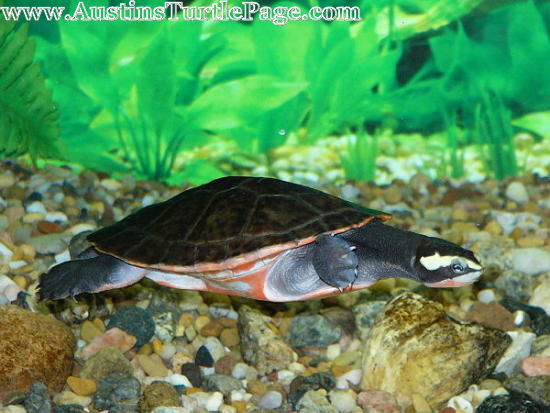 |
|
Photo by Tom C. |
Photo by Tom C. |
6.) New Guinea Snapper - Elseya novaeguineae
Description: General aquatic
basking aquatic body form (somewhat 'slider-like'), dark carapace,
plastron yellowish to pinkish. Rather nervous & like cover. Can be a bit
'nippy.' Have been known to 'play dead.' May bask some. Batagur (Cris
Hagen) noted there are many 'snappers' (turtles of this genus) over the
island of Papua New Guinea/Iryan Jaya, & many people with a 'New Guinea
Snapper' don't actually know its exact species (some 'species' may
not've even been described yet!). Size: Up to 12" SCL.
Pro.s: Hardy. Good swimmer.
Con.s: Eventually quit playing
dead. Some are nippy. Some are capable escape artists from their tanks.
There's at least one (maybe more) similar species that gets larger so be
careful what you're buying. There's a risk of getting a different
species in this genus even if you order the correct species.
Availability & Cost: Not
especially common in the trade but they do turn up, mostly E.
novaeguineae but other species may appear. Hatchlings tend to go for
~ $50 & up. Imported adult 'snappers' of the genus tend to go for ~ $100
- 250.
Known Legalities: None known
in U.S.
Helpful Care Resources:
World Chelonian Trust's Photo Gallery (also
see guide on sexing),
Empire of the Turtle's Info. Page.
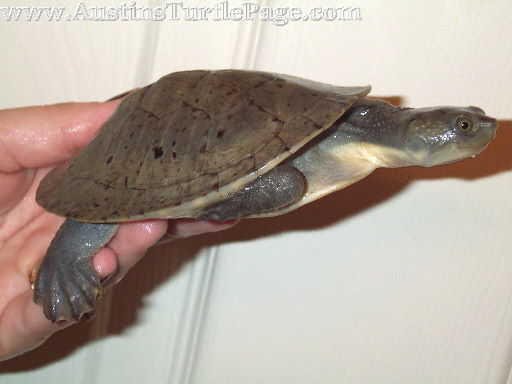 |
|
Photo by Tom C. |
7.)
Indonesian (a.k.a. North Australian) Snake-neck
- Macrochelodina
rugosa (previously Chelodina
siebenrocki)
Description: Medium-Large highly aquatic side-necked species with a
plain dark carapace, yellowish plastron, variably grayish skin & a very long
neck. Predominant carnivores who may eat some Romaine lettuce. Infrequent
basker but provide the option. Active. Recommend at least a 125 gallon aquarium.
Native to New Guinea & Australia. Size: Up to 12".
Pro.s: Neat-looking; resemble sauropod dinosaurs with human-like
faces. Can catch fish. Fairly non-aggressive with humans.
Con.s: Need large enclosures but some are aggressive & must be kept
alone. Tropical & need warm water (figure ~ 80ºF) - not a hibernator. Will eat your fish. Can kill smaller turtles. Not all accept
commercial pelleted foods.
Availability & Cost:
Probably the most available snake-neck turtle in the U.S. Hatchlings ~ $50 - 100
apiece. I've seen a pair of adults for $425.
Known Legalities:
None known in the U.S.
Helpful Care Resources:
ATP Care
Sheet,
Carrettochelys.com's Natural History Discussion,
World Chelonian Trust's
Photo Gallery,
Empire of
the Turtle's Info. Page.
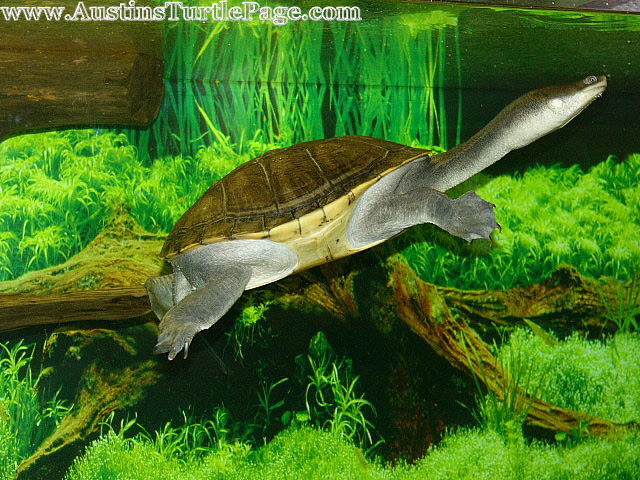 |
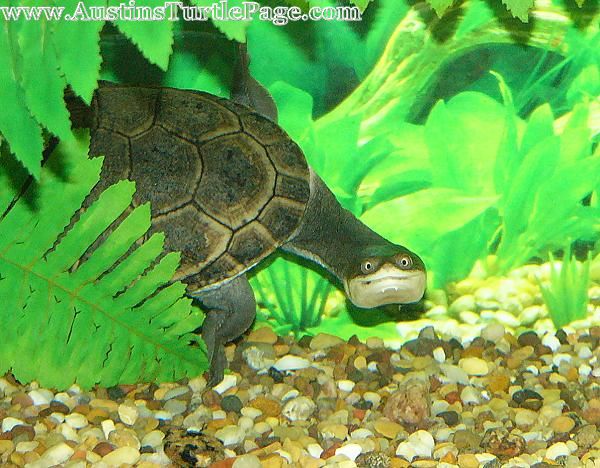 |
|
Photo by Tom C. |
Photo by Tom C. |
8.)
Australian Snake-neck
- Chelodina longicollis
Description: Medium-large highly aquatic side-necked species with a
plain blackish carapace, black-based plastron with light patches, grayish
skin with a lighter underside & a very long neck. Predominant carnivores.
They bask but are shy about it. Active. Recommend at least a 125 gallon aquarium.
Native to Australia. Size: Females up to 11", Males up to 8".
Pro.s: Neat-looking; resemble sauropod dinosaurs with human-like
faces. Can catch fish. Can alter their coloration somewhat over time.
Hibernate in the wild but beware trying this in captivity unless you
research & know the practice well. Can eat on land. Prolific breeders.
Con.s: Need large enclosures. Not all accept commercial pelleted
foods. Hatchlings are delicate. Will eat your fish. Not a tropical
species! They are a temperate species (figure water temp. ~ lower to
mid-70's but no warmer than 75ºF!). Scott Thomson notes they are 'cold climate specialists' & autopsy
has shown kidney failure, liver dysfunction, bone disease & excessive growth in
C. longicollis dept in semi-tropical setups for long periods despite good
diets (so they wouldn't be good tank mates who do need tropical setups).
Availability & Cost:
Rare in the trade; Australian wildlife isn't generally available for legal
export. Batagur (Cris Hagen) noted a legal adult would probably come from a
long-term collection & would likely cost a few hundred dollars. He estimated
hatchlings would run $200 & up.
Known Legalities:
None known in the U.S.
Helpful Care Resources:
ATP Care
Sheet,
Carettochelys.com's Natural History Discussion,
World Chelonian
Trust's Care Sheet,
California Turtle & Tortoise Club Care Sheet,
TurtlePuddle's Care
Sheet,
World
Chelonian Trust's Photo Gallery.
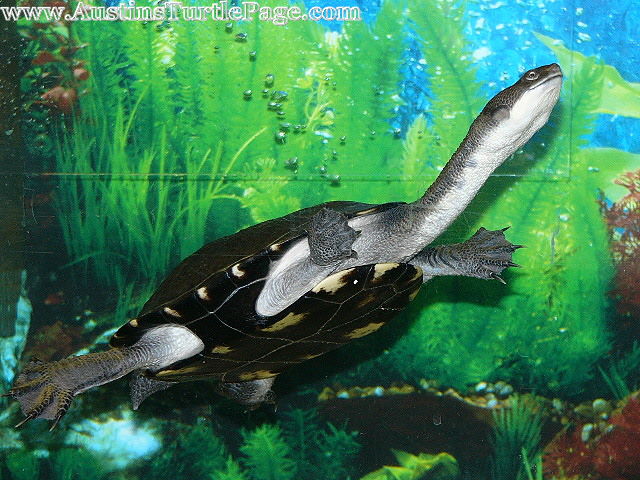 |
|
Photo by Tom C. |
9.)
Chinese Softshell
-
Pelodiscus sinensis
Description: Very flattened-bodies turtles
with long, tapering faces/noses, lips, strongly webbed feet & leathery,
skin-covered flexible shells. Smaller than any North American softshell; even
females (larger than males) are manageable for many. This active medium-sized
turtle should have at a dead minimum a 75 gallon tank, & 125 gallon is better. Hatchlings cute & have an
orange plastron. Size: up to 10” SCL.
Pro.s: Active, elegant swimmers, enthusiastic
feeders, beautiful & very distinctive from hard-shelled turtles. Capable
fishermen. Smaller than North American softies. Slider-like care but beware
abrasive objects in the tank; at least a container of sandy substrate will be
appreciated. Cheap for an exotic. Potentially prolific.
Con.s: Prone to infection
from minor injuries. Leathery shell offers little protection
from predators. More prone to dehydration out of water than many
species. Prefer sandy section of substrate to burrow into. Fast
enough they can be hard to catch in the tank. Can kill your
fish. Have a rep. for violently defending themselves when
handled (which is hard to do). Harder to find than spiny
softies. In
Keeping and Breeding Freshwater Turtles (Page 127) Russ
Gurley1 notes they're prone to sores & fungi & need
heavily-filtered slightly saline environments to thrive
long-term.
Availability & Cost: Uncommon in the pet
trade but somewhat common in the exotic food market (i.e.: some China-Towns) which you fund with
your purchase! Do show up at some larger expo.s (i.e.: annual Daytona Captive
Reptile Breeders' Expo.) Hatchlings ~ $25.
Known Legalities: None known in
U.S.
Helpful Care Resources:
World
Chelonian Trust's Photo Gallery.
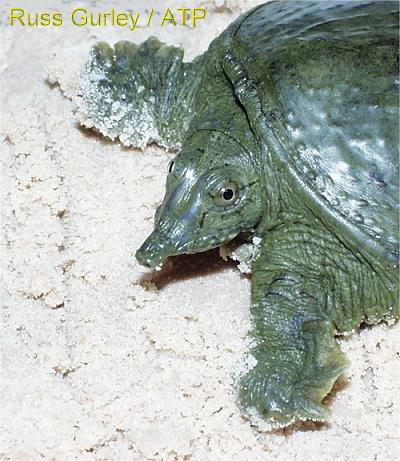 |
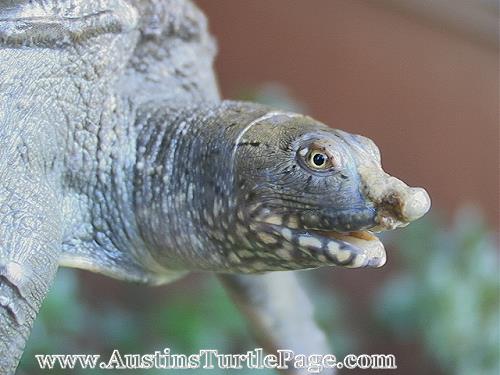 |
|
Photo by Russ Gurley |
Photo by Greg Brashear |
10.)
Malaysian Box Turtle
-
Cuora amboinensis
(4 sub-species)
Description: Medium-sized high-domed semi- (but mostly) aquatic
(unlike North American box turtles!) with
a dark carapace but vivid yellow head & face striping. Much more aquatic
than U.S. box turtles. Recommend at least a 75 gallon aquarium with
standard 'wood turtle-style' care (palludarium-style - both water and land).
Omnivorous. Native to a broad range in Southeast Asia. Size: Up
to 10" SCL+ (but often smaller); Males are smaller.
Pro.s: Really attractive heads. Can
eat out of water.
Con.s: Palludarium-style enclosure with substantial land &
even more water (with some shallow areas) not compatible with many species you
may wish to keep. In Practical Encyclopedia of Keeping & Breeding
Tortoises & Freshwater Turtles (Page 163) Highfield2
states males are mutually highly aggressive; even females may be
attacked & wounded. Imports will need deparasitization. Do not
hibernate. Not very
prolific.
Availability & Cost:
Historically common in the pet trade (ironically came to be regarded as
'common' so many breeders don't work with them!). Hatchlings ~ $55. One of the few
exotics fairly easy to find at some shelters for adoption, like the
Colorado Reptile Humane Society (&
here's their availability
list).
Known Legalities: The entire genus
is now CITES II, which may impact availability over time.
Helpful Care Resources:
World
Chelonian Trust's Care Sheet,
Turtle Puddle's Care
Sheet,
World Chelonian
Trust's Photo Gallery.
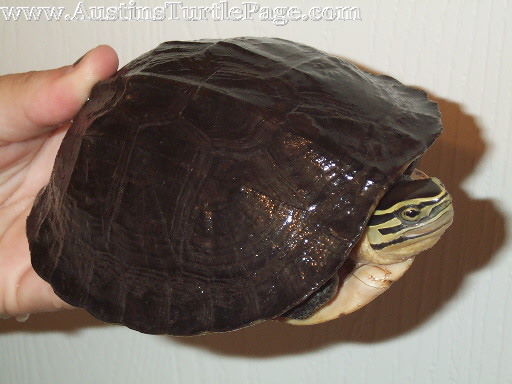 |
|
Photo by Tom C. |
11.) Central
American Ornate Wood Turtle
-
Rhinoclemmys
pulcherrima
manni
Description: Medium-large semi-terrestrial species with a box
turtle-like form-factor but not nearly as domed. Strong bars across the
pupils & the skin is richly patterned with orange high-lights. The carapace
has ornate multi-colored patterning & the plastron is a rich orangish-yellow.
Strongly herbivorous omnivore. Aquatic hatchlings progress to
semi-terrestrial adults. Native to Nicaragua & Costa Rica. Recommend minimum
55 gallon tank. Size: Males
7½"
- 8"
Females
8" - 9"
Pro.s: Very ornate-looking turtle. Can eat on land. Fairly likely to
get along with other turtles. Reputedly intelligent & personable (for
reptiles). Seem to be gaining in popularity in the hobby. The closely
related fellow subspecies R. p. incisa (similar-looking but not quite as
ornate) has been known to lay up to 4 clutches of 3-5 eggs from September -
December3, so I expect R. p. manni to be prolific.
Con.s: Need palludarium-style enclosures with substantial land
and (fairly shallow) water areas. Need for shallower water limits
compatibility with other species. Shallow water can be a hassle to filter.
Availability & Cost:
Somewhat common in the hobby; the closely related but slightly less ornate R.
p. incisa has a fairly strong presence at online vendors, so be careful to
discern which you're getting.
Known Legalities:
None known in the U.S.
Helpful Care Resources:
ATP Care Sheet,
World Chelonian
Trust's Care Sheet,
Buslady's
Care Sheet,
Empire of the Turtle's Photos & Some Info.,
World Chelonian
Trust's Rhinoclemmys Photo Gallery.
12.) South
American Wood Turtle
-
Rhinoclemmys
punctularia
punctularia
Description: Medium-large semi-terrestrial species with a
mildly-to-moderately domed black carapace with lighter under-trim & a smoky
black plastron with lighter patches. They bask. The head is black on top with a
fairly bold red stripe, yellowish on the underside, & the rest of the body
yellowish with a black-specked look. Omnivorous. Native to Columbia, Venezuela,
Trinidad, Guianas & Brazil. Recommend minimum 75 gallon tank. Size:
Male
8" - 10", Female
9" - 11½".
Pro.s: Head coloration fairly striking. Can eat on land. Fairly likely
to get along with other turtles. Reputedly intelligent & personable (for
reptiles). May lay several clutches/year but only 1-2 eggs/clutch3,
so consider fairly prolific with the added complication of incubating 1 or 2
eggs at a time.
Con.s: Need palludarium-style enclosures with substantial land
and
(fairly shallow) water areas. Need for shallower water limits compatibility with
other species. Shallow water can be a hassle to filter.
Availability & Cost:
Strangely variable availability. In the Arizona area,
Zebeck noted they were available in his area ~ twice/year, ~ $20 - 40 wholesale
or $50 - 80 retail in pet stores for imported adults & sub-adults, captive-bred
babies he's almost never seen & he's seen the species 3-4x's in the past 5 years
on the Internet & once on a wholesaler's list. Jeff Dawson in the Ohio area
saw them several times at reptile shows in the past year & listed on the
Internet; he once saw one at a PetsMart (those he saw appeared to be recent
imports, & no hatchlings). In the Texas & Florida areas, Tom C. has
found them at a # of expo.s, typically priced ~ $20 - 25, usually "pretty busted
up" & rough looking. One sex or the other may predominate at an expo. Tom only
saw one at the '04 Daytona Expo. (& that with some coaxing). I finally found
a listing for 5-8" Rhinoclemys punctalaria at $29 in an online
classified.
Known Legalities:
None known in the U.S.
Helpful Care Resources:
ATP Care Sheet,
World Chelonian
Trust's Rhinoclemmys Photo Gallery.
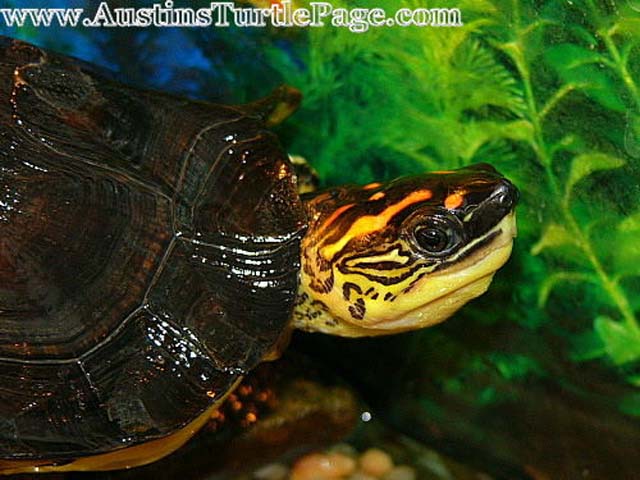 |
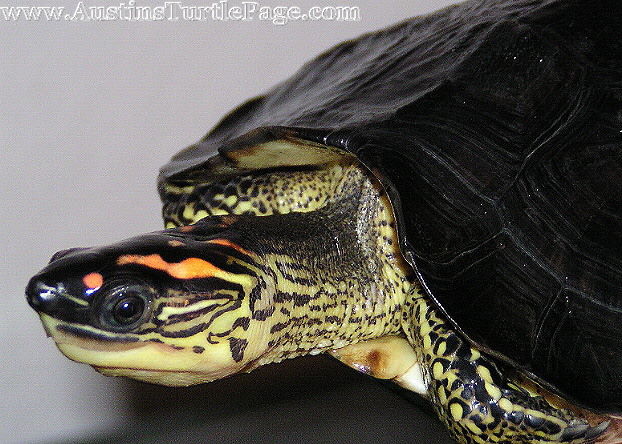 |
|
Photo by Tom C. |
Photo by Tom C. |
13.)
Asian Leaf Turtle
-
Cyclemys dentata
Description: Standard 'basking turtle' form-factor but dark brown
carapace with subtle patterning & a vertebral keel, black skin, dark eyes, & a
dark plastron with attractive streaking. Mainly aquatic young progress to slit
land/water using adults. Omnivorous. Size: Up to 10" SCL.
Pro.s: Another of those subtly handsome species. They are being
captive-bred.
Con.s: Rather drab coloration. Should have a 'wood turtle-style'
enclosure with plenty of land & (fairly shallow) water ('palludarium') as
adults. Frequent import & wild-caughts should be deparasitized.
Availability & Cost: I've seen an adult or sub-adult female for $30,
a couple of unsexed juveniles for $40 apiece & hatchlings for $50 apiece.
Known Legalities: None known in U.S.
Helpful Care Resources:
World Chelonian
Trust's Care Sheet,
Petco's
Online PDF Care Sheet,
World Chelonian Trust's
Photo Gallery.
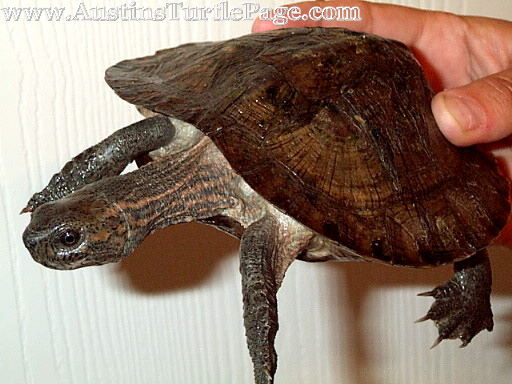 |
|
Photo by Tom C. |
Section IV – Medium-Hard Level Turtles.
Medium-to-large animals requiring large
enclosures or a higher degree of expertise in care or trouble-shooting when
problems arise.
1.)
Belize Slider (a.k.a. Meso-American Slider)
-
Trachemys scripta
venusta
Description: Large basking species with the classic slider
form like RES but on a much larger scale with a more ornate carapace yet lack
red head patches. Omnivorous - more carnivorous as hatchlings, more herbivorous
as they mature. Native to Central American (Mexico to Honduras). Size: Females up to
19"; Males smaller.
Pro.s: Rather ornate carapace. Basic care theory is straight-forward -
essentially a giant RES!
Con.s: Large adults yet a tropical species that can't hibernate. Keepers
aiming for a more unusual or ornate 'RES' may find year-round indoor maintenance
of such a large turtle daunting.
Availability & Cost: Somewhat common in the pet trade. Batagur (Cris
Hagen) has seen hatchlings go for as little as $30. I saw roughly week old
hatchlings offered by a top tier vendor for $40 apiece.
Known Legalities: None known in the U.S.
Helpful Care Resources:
World Chelonian Trust's Trachemys Photo Gallery.
 |
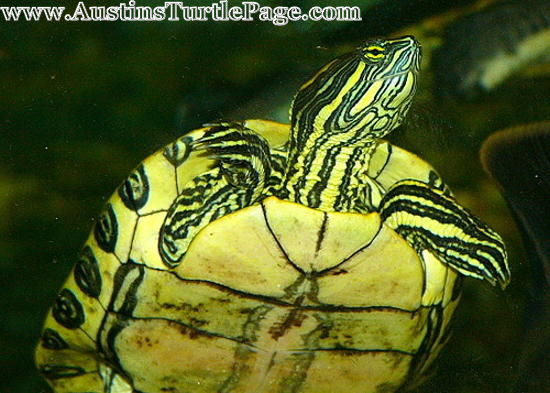 |
|
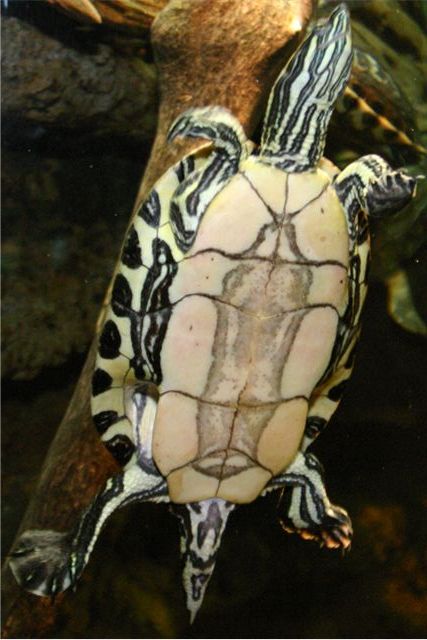 |
|
Middle Photo by Tom C.; Top &
Bottom Photos by Richard Lunsford |
2.)
Nicaraguan Slider -
Trachemys venusta
emolli
Description: Size: Females up to 14" SCL; males smaller.
Pro.s: Attractive basking turtles with standard 'slider-style' care on a
larger scale.
Con.s: Large adults yet a tropical species that can't hibernate. Keepers
aiming for a more unusual or ornate 'RES' may find year-round indoor maintenance
of such a large turtle daunting.
Availability & Cost: Uncommon in the trade but can be found with
persistence. Hatchlings ~ $30 - 45.
Known Legalities: None known in U.S.
Helpful Care Resources: Let us know if you find any good ones.
3.)
Red-headed Amazon River Turtle
-
Podocnemis
erythrocephala
Description: Medium-large basking species, dark-brown carapace & dark
skin, with striking red coloration on the head that may fade somewhat with age.
Face more reminiscent of a short-muzzled dog than the 'frog-face' of sliders &
male map turtles. Omnivorous hatchlings progress to predominantly herbivorous
adults. Recommend at least a 125 gallon tank. Size: Females to 13", Males
smaller.
Pro.s: Quite beautiful & distinctive. Fairly small for a Podocnemis.
Due to not being ESA-listed can cross state lines much easier than a Yellow-spotted.
Con.s: Quite sensitive to chills; can sicken & die afterward - must
never get cold!
Podocnemis
species are thought
to benefit from low pH. Very rarely bred successfully in captivity
so most available are wild-caught imports & should be deparasitized.
Availability & Cost: Uncommon but occasionally available. Cost
around $750 - 1,000 apiece.
Known Legalities: CITES II.
Helpful Care Resources:
World Chelonian Trust's
Podocnemis Photo Gallery.
4.) Spot-bellied
Side-neck
-
Phrynops hilarii
Description:
Large side-necked basking species similar in form to sliders with a large,
broader head & (more 'people-like') face, dark drab carapace, pale
dark-spotted plastron, whitish skin & gray heads with striping. Omnivorous.
Recommend at least a 360 gallon tank for a large male, & 500+ gallons for a
large female. Native to Southern Brazil, Uruguay & Argentina. Size:
Females up to 16", Males smaller.
Pro.s:
Beautiful viewed gliding about a massive enclosure.
Con.s:
Females are very large & rather bulky. Need massive enclosures. In Keeping
and Breeding Freshwater Turtles (Page 174)1 Gurley noted turtles
in this genus are often aggressive to each other & larger ones may eat small
turtles. Eric B. at Empire of the Turtle recommends pH 6.5 or slightly
lower, esp. for hatchlings38, which may be hard to provide if
your tap water is hard & alkaline.
Availability & Cost:
Somewhat common in the pet trade. I've seen a juvenile > 1 yr old offered
for $175.
Known Legalities:
None known in U.S.
Helpful Care Resources:
ATP Care
Sheet,
World
Chelonian Trust's Phrynops Photo Gallery,
Empire of
the Turtle's Info. Page.
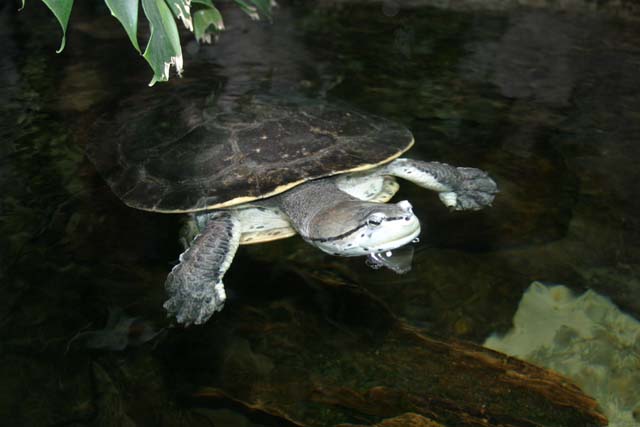 |
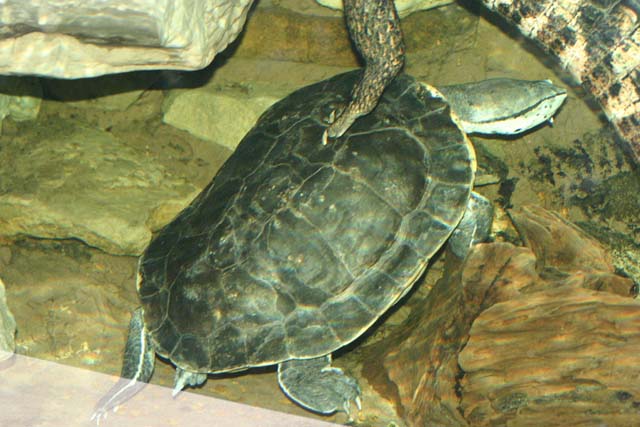 |
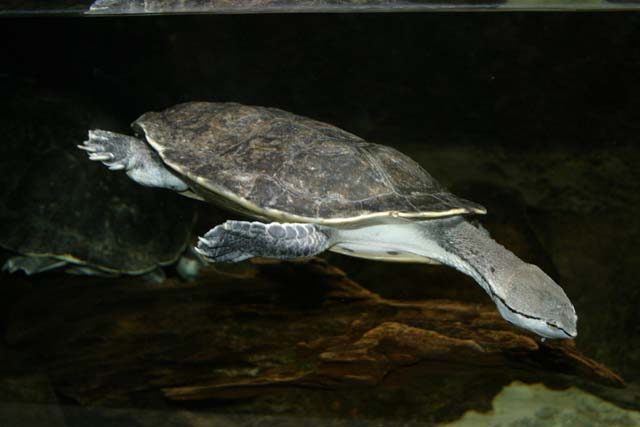 |
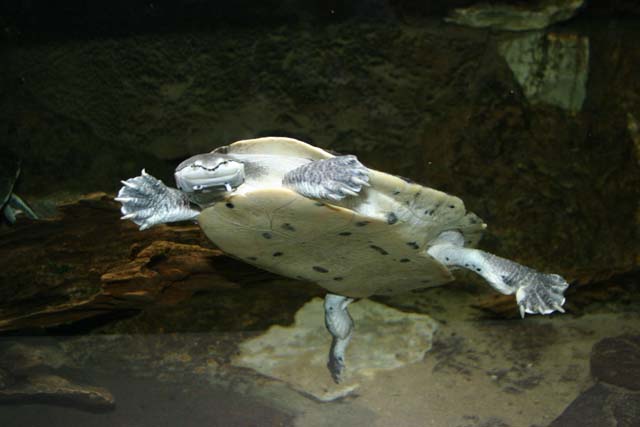 |
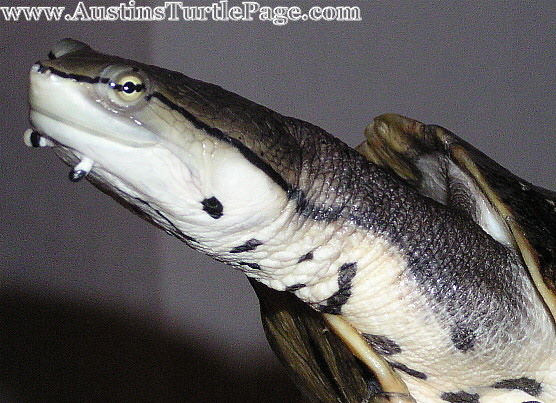 |
Top right & left - Female at
Nashville Zoo
Middle right & left - Male
at Nashville Zoo
Photos by Richard Lunsford
Bottom left - Male named
'Stripe' - Photo by Tom C. |
6.)
Argentine Snake-neck
-
Hydromedusa
tectifera
Description: Medium-large highly aquatic side-necked species with a rich
dark-brown carapace, grayish to brownish skin, striped (& somewhat flattened) head & a very long neck.
Predominant carnivores. Rarely bask but provide the option. Recommend at least a
75 gallon aquariums with plenty of cover (i.e.: driftwood & floating plants). Native to South America.
Size: Males 7 - 9", Females
9 - 12".
Pro.s: Strikingly ornate as snake-necks go. Can catch fish (strike &
suck maneuver, like a chicken turtle). Hibernate in the wild (I don't recommend
trying it in captivity.
Con.s: Prone to health problems, especially if not kept in acidic water.
Sensitive to poor water quality (i.e.: eye, skin & respiratory infections) per
Practical Encyclopedia of Keeping & Breeding Tortoises & Freshwater Turtles
(Page 194-195) Highfield2. Can kill your fish. May be slow to transition to commercial pelleted foods
(one of the hardest species to convince).
Availability & Cost: I've seen 4-5" captive-bred at ~ $225 apiece, &
a large (8" SCL) fairly long-term captive male offered for $400 shipped.
Known Legalities: None known in U.S.
Helpful Care Resources:
ATP Care Sheet,
California Turtle &
Tortoise Club Care Sheet,
World Chelonian
Trust's Photo Gallery.
7.)
Indian Spotted Pond Turtle
-
Geoclemys
hamiltonii
Description: Basking aquatic bulkier & more domed with a larger head
than a RES. Dark black with small yellow spots on both carapace & skin. Plastron
lighter black with light streaks. Carnivorous. Recommend at least a 125 gallon
tank. Enclosure design similar to a slider but given bulkier build provide some
supporting 'tank furniture' (i.e. driftwood) for underwater support/resting
areas. Native to rather clear well-vegetated fairly shallow waters11
in Indian, Pakistan & Bangladesh. Size: Females up to 12",
males slightly smaller.
Pro.s: Quite beautiful & very unusual in private collections. Reputedly
hardy. Basically all are captive-bred.
Con.s: Rather large & bulky. Tropical species albeit with some cold
tolerance - do not hibernate them. No wild-caughts. The hardest part of keeping
one is
acquiring it (CITES I).
Availability & Cost: There are very few private breeders in the
U.S. I saw these for sale at the Daytona Captive Reptile Breeders' Expo. '04
(there, captive-bred 'babies' were $333, '02's $500 & '01's $750)..
Hatchlings ~ $450.
Known Legalities: CITES Appendix I. Also covered by the Endangered
Species Act. Available in Florida & Georgia.
Helpful Care Resources:
Asian
Turtle Consortium Care Sheet,
World Chelonian Trust's
Photo Gallery.
8.) Chinese Yellow Marginated Box Turtle
- Cuora flavomarginata
(Some people use the genus Cistoclemmys) (There are
sub-species)
Description: Medium-sized
high-domed semi-aquatic with a dark reddish-black/brown carapace with a
single light dorsal stripe but vivid yellow-striped (behind eye)
light-colored head. They can close up tightly. Eric B. noted they're
more terrestrial than Malaysian box turtles (C.
amboinensis). Temperate to sub-tropical. Recommend
at
least a 75 gallon aquarium with standard 'wood turtle-style' care (palludarium-style
- both water and land). Omnivorous. Native to Taiwan, Southern China &
the Ryukyu Islands. Size: Up to ~7" SCL.
Pro.s: Really attractive heads. Can
eat out of water. Can hibernate.
Con.s: Palludarium-style
enclosure with substantial water (with some shallow areas) & even more
land not compatible with many species you may wish to keep. They like to
keep to cover. Males may be aggressive toward each other. Imports will
need deparasitization. Fairly prolific (but clutches are quite small).
Availability & Cost:
Less common in the pet trade than Malaysian box turtles (C.
amboinensis). I've seen an adult male for $200.
Known Legalities: The entire genus
is now CITES II, which may impact availability over time.
Helpful Care Resources:
California Turtle
& Tortoise Club's Care Sheet,
TurtlePuddle's Care Sheet,
Empire of the Turtle's Info. Page,
Carapace & Plastron Views,
Oakland Zoo's
Info. Page,
HeartSong
Sanctuary's Info. & Pics Page,
World
Chelonian Trust's Photo Gallery for the genus &
guide to sexing this species,
Valerie Haecky's Species
Notes.
9.)
Black Wood Turtle
- Rhinoclemmys
funerea
Description: Very large turtle with overall form similar to a slider but
thicker body (more so even than a female cooter), larger head, dark blackish
carapace & light-colored base skin with lots of dark patterning. Largest of the
wood turtles & more aquatic than most. Omnivorous. Size: Up to 14" SCL
(some say larger)
but bulky for that length.
Pro.s: Attractive if you're in the market for a large, thick-bodied
semi-aquatic omnivore that's not too huge.
Con.s: Very large (both long, wide & very thick-bodied) turtle typically
kept in a traditional large aquatic setup (i.e.: like a RES habitat) but other
wood turtles are said to have 'palludarium-style' needs - so I wonder if an
aquatic setup is a trade-off since a palludarium for R. funerea would be
huge (although it's supposedly more aquatic than some of the other wood turtles).
Availability & Cost: Fairly common at online vendors.
Hatchlings ~ $40-60.
Known Legalities: None known in U.S.
Helpful Care Resources:
Photo & some basic info.,
World Chelonian
Trust's Rhinoclemmys Photo Gallery.
10.)
Matamata
-
Chelus fimbriatus
Description: Very large flattened turtle with a mottled brown 'pile of
dead leaves' coloration. Brown carapace with horn-like knobs reminiscent of a
young alligator snapper. Head & neck flattened & bear irregular fleshy
projections for camouflage. Nose resembles a short straw. Carnivorous - mainly a
fish-eater. Not thought to bask.
Recommend minimum 300 gallon tank for a large adult. Native to the Amazon River
& its tributaries. Size: Up to 18".
Pro.s: Very unique looking. 'Vacuum' feeding style. Somewhat sedentary
(but can swim) so enclosure needn't be as large as some comparably large turtles
(i.e.: Florida softshells).
Con.s: The large head & neck make the turtle even larger than the 18"
SCL suggests. Youngsters are rather delicate & even older juveniles (perhaps 5")
sometimes die without clear cause. Mainly feed on live fish (be mindful of
thiaminase & chemical treatment risks!) - not apt to accept commercial pelleted foods. Require high water quality & low pH. Sedentary life-style
mandates enclosure allow the turtle to reach the surface for air without
swimming.
Availability & Cost: Strangely somewhat common in the online pet trade.
I've seen a couple of 4.5" SCL juveniles at $300 apiece, & a 12" SCL juvenile offered at ~ $450.
Known Legalities: None known in U.S.
Helpful Care Resources:
California Turtle &
Tortoise Club Care Sheet,
David Kirkpatrick's Care
Sheet,
World Chelonian
Trust's Care Sheet,
CentralPets.Com's Care Sheet,
World Chelonian Trust's
Photo Gallery.
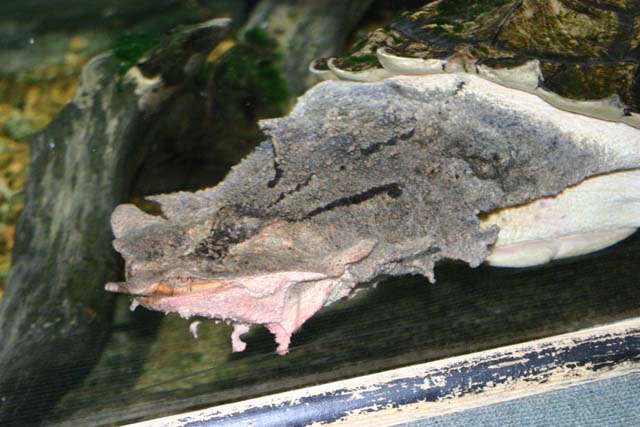 |
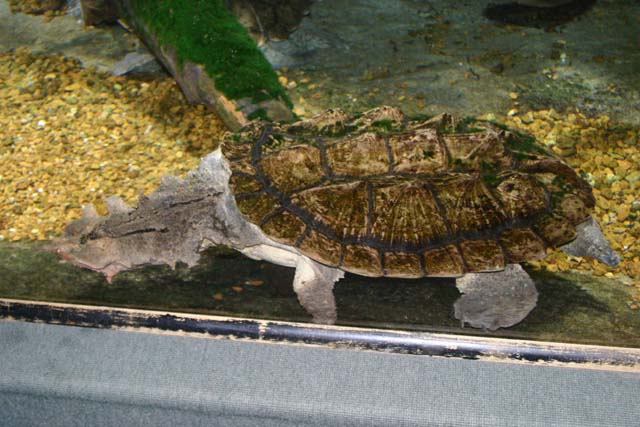 |
|
Photo by Richard Lunsford at
Nashville Zoo |
Photo by Richard Lunsford at
Nashville Zoo |
11.)
Giant Musk Turtle
-
Chiapas Giant Musk
-
Staurotypus
salvinii
& Mexican Giant Musk -
Staurotypus triporcatus
Description: Resemble a giant stinkpot, with lighter, more
'speckled-looking' skin, & the carapace as longitudinal ridges. Reduced plastron
per all musks. The head is quite large. Largely carnivorous. Recommend at least
a 300 gallon tank. Basking should be possible even if seldom seen. S.
triporcatus native to Mexico & Belize;
Staurotypus
salvinii native to Mexico & Guatemala to El Salvador. Size:
S.
salvinii up to 10" SCL.
S. triporcatus to 15" SCL.
Pro.s: Lack the 'power strike' of common snappers, making them
(comparatively) fairly
safe to handle if you're careful & know what you're doing!
(Disclaimer: our observations are in good faith, we're not advocating handling
them, it can be dangerous, & if you get hurt don't even think about suing
us!). Available captive-bred.
Con.s: Very large size & decent activity level mandate large enclosures;
the two I've seen in public exhibits were in water a few feet deep (perhaps to
accommodate other species) so aim for at least 18" depth to allow swimming room
(& underwater rest areas near the surface if deeper) - this is not a
giant shallow water mud turtle! Willing to bite & large, powerful jaws make the bite quite dangerous.
Availability & Cost: Somewhat uncommon at vendors but easy to find
if you keep looking. Hatchling S.
salvinii ~ $65 (I saw a 1 year old captive-bred
female for $90). I've seen adult pairs at $300 apiece. I've seen a juvenile S
triporcatus (? 4" SCL?) for ~ $150, a pair of 8" captive-bred
(non-related) for $350, & hatchlings a few months old for ~ $40.
Known Legalities: None known in U.S.
Helpful Care Resources:
World
Chelonian Trust's Staurotypus Photo Gallery.
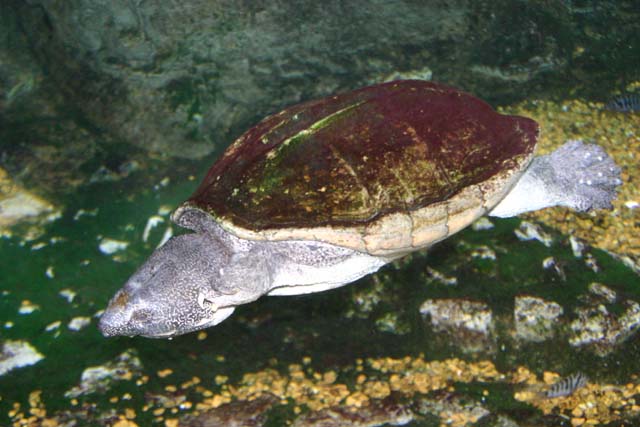 |
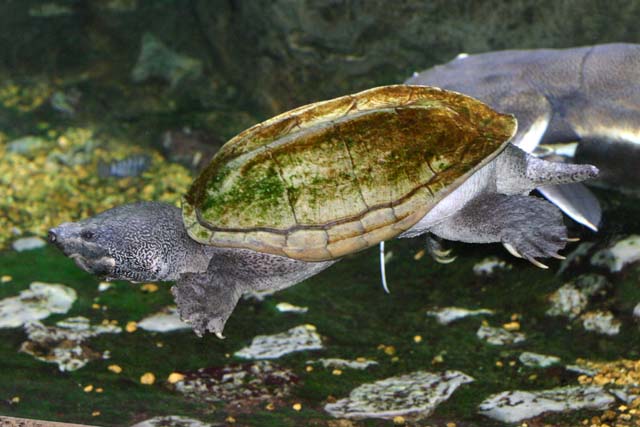 |
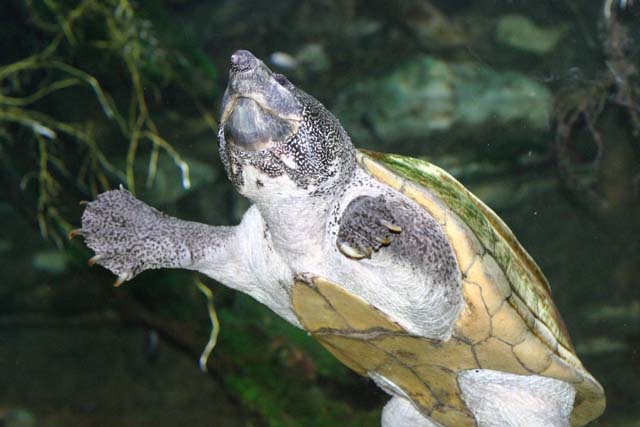 |
S. triporcatus Photos by Richard Lunsford taken
at Nashville Zoo
|
12.)
Asian (a.k.a. 'Chinese') Big-Headed Turtle
-
Platysternon megacephalum (there are sub-species)
Description: Superficially resembles a common snapper (bulky, drab
coloration, long tail) with a large-to-massive head. Well-developed plastron
(unlike snappers) with no hinge. Climb very well. Native to China, Vietnam,
Thailand & Myanmar (inhabitat solitary pools assoc.'d with cold mountain streams22).
Size: Up to 11" But most stay smaller (5 - 7")22.
Pro.s: Distinctive-looking; quite a conversation piece.
Con.s: Hard to find & very expensive. Skilled climbers may escape your enclosure. Powerful jaws,
vigorous carnivory, aggression toward each other22 & specialty
habitat needs (cool, shallow, well-oxygenated water) mandate keeping alone. Can
be fairly sedentary. Somewhat prone to shell fungal infections. Most are wild-caught & need deparasitization. Hard to
breed.
Availability & Cost: Rare in the pet trade but they do turn up
if you're persistent. Very costly - expect to pay several hundred for an import
(some big-heads were offered at $650 apiece in Sept. '04, & 4 4-4.5" at $350
apiece 3-27-05), & it could in theory cost perhaps $1,000+ for
a true captive-bred hatchling.
Known Legalities: CITES Appendix II.
Helpful Care Resources:
Asian Turtle Consortium Care Sheet,
David Kirkpatrick's
Care Sheet Article #1,
David Kirkpatrick's
Care Sheet Article #2,
CentralPet.Com's Care Sheet,
Platysternon.com (a web site dedicated to the species),
World Chelonian
Trust's Platysternon Photo Gallery.
13.) Twistneck Turtle -
Platemys
platycephala
platycephala
Description: Basking side-necked species with a somewhat flattened dark
brown/mottled carapace (with 2 keels) & dark skin but a bright yellowish
brown top of the head &
neck. Care similar to a North American Wood Turtle. Recommend enclosure at least a
55 gallon tank
(due to land & water requirements). Native to northern South America. Size: Up to 7.5" SCL.
Pro.s: Oddly handsome & striking in a subdued way. Endearing to look at.
Con.s: Native habitat use of both land & shallow water mean captive
enclosure should be 'palludarium-style' with substantial land & shallow water
areas - this may be incompatible with some other species' needs. Ideally should
have low pH water. Tropical - don't try hibernating them. Low egg production &
delicate hatchlings may frustrate would-be breeders.
Availability & Cost: Uncommon in the trade but can be found with
persistence. I've seen imports ~ $65 (not hatchlings), & some unspecified 4-5"
SCL for $35.
Known Legalities: None known in the U.S.
Helpful Care Resources:
ATP Care Sheet,
California Turtle &
Tortoise Club Care Sheet,
TurtlePuddle's Care
Sheet,
World
Chelonian Trust's Photo Gallery.
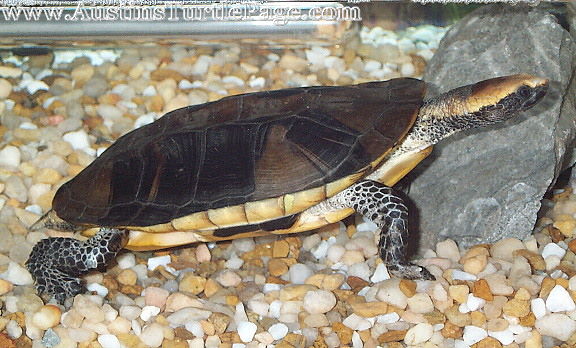 |
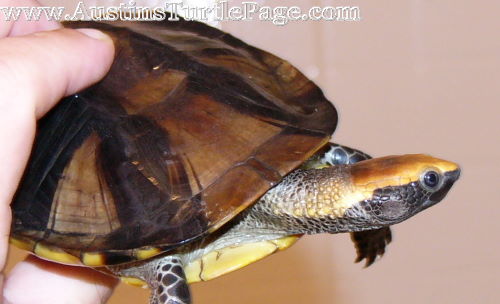 |
|
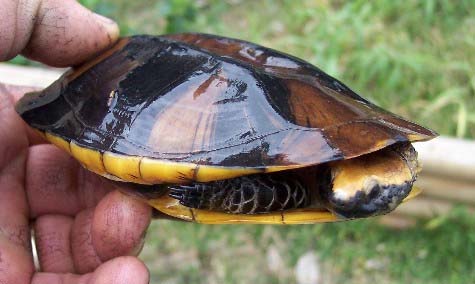 |
Top right & left photos by Tom C.
Bottom left photo by Turtle Pimp |
14.) Spiny Turtle -
Heosemys spinosa
Description: Medium-sized semi-terrestrial turtle with a handsome brown
shell with a dorsal row of small spikes & larger spikes around the carapace
perimeter (warning: adults may lose the spines!). Predominantly (not always exclusively) herbivorous. Recommended
enclosure quite large due to need for land & water sections (ideally large
outdoor setup, but indoors at least 125 gallon tank). Native to Thailand,
Sumatra, Borneo & Indonesia. Size: Up to 9" SCL.
Pro.s: Strange appearance (like a cross between a U.S. wood turtle & a
rose bush!). Red spotting on the black head is attractive. Medium-sized.
Con.s: Delicate even as adults; strong reputation for being prone to
sicken & die. Need large palludarium-style enclosure with plenty of land &
(fairly shallow) water. On the other hand, per
Keeping and
Breeding Freshwater Turtles (Pages 245-246)1 may do best in
'cool' environments ~ 75-80ºF, outdoors (not so well indoors), & in nature tend
to inhabit cool streams at high altitudes12. Captive breeding is very rare so any 'pet'
is wild-caught unless proven otherwise & must get antibiotic deparasitization.
Wild-caughts have fairly high mortality12. Not a prolific species.
Availability & Cost: Rather rare in the pet trade. I've seen
imported adult males at ~ $50 piece. I saw a 4" for ~ $100.
Known Legalities: CITES Appendix II.
Helpful Care Resources:
World Chelonian
Trust's Care Sheet,
TurtlePuddle's Care
Sheet,
World Chelonian
Trust's Photo Gallery.
Section V - Hard Turtles.
Require larger enclosures, are harder to
obtain or otherwise require a greater investment of skill or resources yet don't
reach the extremes.
1.)
Yellow-spotted Amazon River Turtle
-
Podocnemis unifilis
Description: Very large basking species, dark-colored carapace (brownish
to black) & skin, with bright yellow spots on male's heads. Face more reminiscent of a short-muzzled dog than the 'frog-face' of
sliders & male map turtles. Omnivorous hatchlings progress to predominantly
herbivorous adults. Recommend at least a 360 gallon tank & preferably much
larger. Size: Females to 28" (most do not get that large), Males smaller.
Pro.s: Beautiful animals. May fit the bill when really large turtles are
needed (i.e.: Zoo exhibits).
Con.s: Quite sensitive to chills; can sicken & die afterward - must
never get cold!
Podocnemis
species are thought
to benefit from low pH. Females don't have the prominent yellow
head spots.
Availability & Cost: A few hatchlings turn up at some of the largest
expo.s. At Daytona Captive Reptile Breeders' Expo. '04 there were some juveniles
(SCL a few inches) at $400 apiece; 3 year olds were $250. Due to ESA status difficult to take out-of-state.
Known Legalities: CITES Appendix I. Also covered by the Endangered
Species Act (ESA).
Helpful Care Resources:
ATP
Care Sheet,
World Chelonian Trust's Care Sheet,
World Chelonian Trust's
Podocnemis Photo Gallery.
2.) Painted River Turtle -
Callagur borneoensis
Description: Very large basking aquatic species, gray-skin, fairly drab,
but breed-ready males' heads & necks turn white with a black face & a strong red
slash down the dorsal center of the head. Mainly herbivorous. Native
to Southeast Asia (estuaries & tidal reaches of rivers). Recommended a pond of at least a few thousand gallons for a
large adult female. Size: Females up to 28" SCL, Males up to 20".
Pro.s: Impress the neighbors. Some vegetarian keepers may prefer
herbivorous pets. 'Breed-ready' males' coloration rather striking.
Con.s: Very large adults. Can be aggressive to their own kind, esp. when
crowded. Tropical species so don't hibernate, but somewhat 'cool-tolerant.' The
vivid breeding male coloration isn't constant & most of the time these turtles
are fairly drab. Large herbivores produce a lot of waste. Breeding isn't simple
to engineer.
Availability & Cost: Rare in the trade but can be found (Turtle Pimp
has offered these). Hatchling ~ $175-250. I've seen an 8" SCL 3 year old
captive-born offered for ~ $400.
Known Legalities: CITES II.
Helpful Care Resources:
California Turtle &
Tortoise Club Caresheet,
World Chelonian Trust's
Photo Gallery.
3.)
Fly River Turtle
- Carettochelys insculpta
Description: Large softshell-like aquatic species (shells skin-covered
without scutes) with a thicker body, 'flipper-like' limbs & an oddly snout-like
nose. Olive gray carapace with some light patches along the rim & a bland white
carapace. Omnivorous - a predominant herbivore but will definitely eat meaty
foods. Recommended minimum 360 gallon tank for large adult; even the smaller
specimens seen in captivity need 200 gallons+. Native to Australia, New
Guinea & Irian Jaya. At least in Australia they hail from alkaline hard-water
habitat. Almost never bred in captivity so those for sale are either wild-caught
or 'captive-hatched' from wild-collected eggs. Size: Up to 22" SCL length &
49.5 lbs, but captives seldom attain such size.
Pro.s: Appear graceful, serene & gentle in their movements (but can
display bursts of speed when startled). Not basking spot required. Slow growing.
Usually eat commercial foods.
Con.s: Large, require pristine water quality to maintain health, need
unusually warm water, very prone to attack other turtles (including their own
kind) & must usually be housed alone or in very large, complex enclosures. Even
one mandates a large enclosure. Native to alkaline hard-water
environs inhospitable to many microorganisms; consider offering either alkaline
hard water or using a UV-Sterilizer on the tank. Particularly susceptible to fungal white-spot & moderately vulnerable to SCUD.
Poor candidate for breeding in captivity & all in the pet trade are
either wild-caught or 'captive-hatchling' (from wild-collected eggs).
Availability & Cost: Have been somewhat common on online dealer classifieds
but since CITES II assignment the supply will probably drop off sharply. Tend
to run ~ $300 - $700 in the U.S. (can be dirt-cheap overseas; went to CITES II
in '04 which may impact availability & cost).
Known Legalities: Became CITES II in '04. The legality of those brought
into the U.S.A. beforehand was dubious.
Helpful Care Resources:
Carettochelys.com
(Large amount of info.;
here's
their care sheet), ATP
Care Sheet, California
Turtle & Tortoise Club Care Sheet,
Yahoo! Discussion Group
on FRTs,
World
Chelonian Trust's Photo Gallery,
World
Chelonian Trust Guide to Sexing FRT's.
Section VI – High-Level Turtles.
Either require
very high-cost &/or huge enclosures or otherwise a large-scale investment to maintain well.
Some turtles at this level begin to approach the challenge of providing
enclosures for mid-range crocodilians & large constrictors & the largest
venomous snakes. While far less dangerous than those animals, so of these
turtles can take fingers off.
1.)
Asian Narrow-headed Giant Softshells -
Striped Narrow-Headed Softshell -
Chitra chitra
(2 sub-species), Indian
Narrow-Headed Softshell -
Chitra
indica.
Description: Classic large softshell body except a thick-based neck
tapers to a comically small head. They should have cool water & a sand
substrate. C. chitra native to Malaysia. C. indica native to Pakistan, India & other places. Size: C. indica can reach a breath-taking 49" SCL & weigh
up to 200 lbs! Chitra chitra are potentially even more enormous; Cris
Hagan (Batagur) know of one in a private collection in Thailand measuring
slighter over 4 feet SCL & weighing around 265 lbs!
Pro.s: Impressive-looking & some have a striking striped pattern (C.
chitra allegedly retains its coloration well, but C. indica does not).
Can catch fish.
Con.s: Require pristine water quality, sand substrate & large enclosure.
Should have aquarium salt added to their water20. In nature C.
indica spend a lot of time buried in sandy bottoms so use of other or no
substrate is not advised. Delicate hatchlings, particularly Chitra chitra.
Large enough to have a serious bite. May
refuse commercial foods & demand natural prey
(fish), so
thiaminase & whatever chemical
treatments the fish were exposed to are a concern. Will eat your fish.
Supposedly fairly sedentary but still require large enclosures (just not a
full-size swimming pool!).
Availability & Cost: As of 3-2-05 a 19-20" C. chitra at
Chitrachitra.com will run you $1,300 + paperwork & shipping (adding hundreds
more - hey, we're talking CITES paperwork & shipping from Malaysia!).
Known Legalities: Chitra species are CITES Appendix II.
Helpful Care Resources:
Asian Turtle
Consortium Chitra indica Care Sheet,
Chitra chitra.com (they produce
captive-bred (they even do morphs) & the site discusses care & potential
problems),
World Chelonian
Trust's Chitra Photo Gallery.
2.)
Giant Amazon River Turtle
-
Podocnemis expansa
Description: Very large basking aquatic species, dark-colored shell (grayish to
black) & skin. Face more reminiscent of a short-muzzled dog than the 'frog-face'
of sliders & male map turtles. Omnivorous hatchlings progress to predominantly
herbivorous adults. Recommend a pond of at least a few thousand gallons for a
large adult female. Size: Females to 44" SCL, Males smaller.
Pro.s: Large specimens impress visitors.
Con.s: Very large adults. Quite sensitive to chills; can sicken & die
afterward - must never get cold!
Rather drab.
Podocnemis
species are thought to benefit from low pH.
Availability & Cost: Not available to general hobbyists; can be had
by some large public institutions (i.e.: Tennessee Public Aquarium in
Chattanooga). Cost would probably be extreme.
Known Legalities: CITES Appendix II. Also covered by the Endangered
Species Act.
Helpful Care Resources:
World Chelonian Trust's
Podocnemis Photo Gallery.
3.) Black Ray Softshell - Amyda cartilaginea
Description:
Very large softshells turtles with the same basic body form as the North
American softies (i.e.: spiny softshell) on a much larger scale. Recommend very
large enclosure (at least 1,000 gallon stock tank). Native to
Vietnam, Laos, Thailand, Burma, Malaysia, Java, Sumatra & Borneo. Size:
Females up to 28"; Males smaller.
Pro.s:
Very impressive-sized adults.
Con.s:
Swimming pool-sized enclosures for tropical species are expensive & challenging.
Softshells in general depend on high water quality least they develop bacterial
&/or fungal infections. The North American softshells can all bite & scratch
effectively & the Black Ray takes it to a whole new level; I'd expect this
turtle to be capable of removing a finger (a massive one might be able to mangle
a hand).
Availability & Cost:
Very rare in the pet trade but not unknown (a large adult import was offered
online once). Common in the Asian animal trade, so they may be available to some
of our non-U.S. members. In some foreign markets (i.e.: Thailand, Malaysia) may
cost several dollars or more.
Known Legalities:
CITES II.
Helpful Care Resources:
ATP Care Sheet.
An info. page at Ecology Asia,
World Chelonian Trust's
Photo Gallery of BRS',
Another brief info. page.
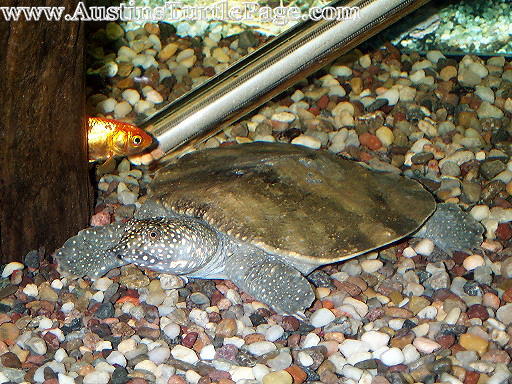 |
|
Juvenile Black Ray Softshell - Photo by Tom C. |
Appendix I.) List of Exotic Turtles covered in this
article.
Not all exotic turtles are covered in this
article. I chose a representative majority of those species apt to be purchased
by pet seekers.
1.)
Exotic Sliders.
a. Belize
Slider.
b. Nicaraguan
Slider.
2.)
Amazon River Turtles & Similar.
a. Yellow-spotted
Amazon.
b. Red-headed
Amazon.
c. Giant
Amazon River Turtle.
d.
Spot-bellied Sideneck.
3.)
Miscellaneous Medium Basking Turtles.
a. European
Pond Turtle.
b.
Chinese Golden-Thread.
c. Caspian Creek Turtle.
d. Japanese
Pond Turtle.
e. Red-bellied
Short-neck.
f. Indian
Spotted Pond Turtle.
4.)
Miscellaneous Bottom-Walkers.
a. African
Helmetted Turtle.
b. Red-cheeked
Mud Turtle.
c. White-throated
Mud Turtle.
d. Scorpion Mud Turtle.
e. White-lipped Mud Turtle.
f. Chinese
Big-headed Turtle.
g. Matamata.
5.)
Partial Bottom-walker Turtles.
a.) Reeves Turtle.
b.) Kwangtung River Turtle.
c.) Giant Musk Turtle (Chiapas & Mexican).
6.)
Exotic Wood Turtles & Similar 'Palludarium' Species.
a.) Central American Ornate Wood Turtle.
b.) South American Wood Turtle.
c.) Black Wood Turtle.
d.) Twistneck Turtle.
e.) Spiny Turtle.
f.) Malaysian Box Turtle.
g.) Asian Leaf Turtle.
h.) Black-Breasted Leaf Turtle.
i.)
Chinese Yellow Marginated Box Turtle
7.)
Softshells & Similar Turtles.
a.) Chinese Softshell.
b.) Chitra Softshells.
c.) Fly River Turtle.
Appendix II.) Exotic Turtles by Difficulty
Level.
Remember difficulty is multi-factorial &
situationally dependent. For a Florida resident with good income & access to the
Daytona Captive Reptile Breeders' Expo., an Indian Spotted Pond would be of
Medium difficulty. To me in Kentucky, with no means to purchase ones across
state lines, it would be Hard or Very Hard due to the challenge of acquisition
(which would likely bend or break the law). And a Black-breasted Leaf Turtle can
make do with a small tank in a dorm room, whereas a large adult Australian
Snake-neck will not.
Level I.) The Best Starter
Turtles: Red-cheeked Mud, White-Lipped Mud, Scorpion Mud, Reeve's
Turtle.
Level II.) Second Choice
Starter Turtles: White-Throated Mud, European Pond Turtle, Chinese
Golden Thread Turtle, African Helmetted Turtle.
Level III.) Medium-Level
Turtles: Black-breasted Leaf Turtle, Caspian Creek Turtle, Japanese Pond
Turtle, Kwangtung River Turtle, Red-bellied Short-neck, New Guinea Snapper,
Indonesian Snake-neck, Australian Snake-neck, Chinese Softshell, Malaysian Box
Turtle, Central American Ornate Wood Turtle, South American Wood Turtle, Asian
Leaf Turtle.
Level IV.) Medium-Hard
Turtles: Belize Slider, Nicaraguan Slider, Red-headed Amazon River
Turtle, Spot-bellied Side-neck, Argentine Snake-neck, Indian Spotted Pond
Turtle, Black Wood Turtle, Matamata, Chiapas Giant Musk Turtle, Mexican Giant
Musk Turtle, Asian Big-headed Turtle, Twistneck Turtle, Spiny Turtle.
Level V.) Hard Turtles:
Yellow-spotted Amazon River Turtle, Painted River Turtle, Fly River Turtle.
Level VI.) High-Level
Turtles: Asian Giant Narrow-headed Softshells, Black Ray Softshell,
Giant Amazon River Turtle.
Appendix III.) Exotic Turtles by Ease of
Acquisition.
Easy to Acquire: No
non-U.S. turtle is as easily acquired across the U.S. as the most common U.S.
species (i.e.: RES); thus none get a blanket 'easy' rating here.
Fairly Easy to Acquire:
Can usually be found in a busy Classifieds section or amongst a group of popular
vendors (maybe 2 out of 5 will have it).
Fairly Uncommon in the
Trade: Can usually be found somewhere on a busy Classifieds section, but
may be few, adults only, or be found only at 'Brand X' vendors.
Uncommon: Show up
occasionally on Classifieds sections but not constantly. May require scanning
the Classifieds for a few weeks. Also species with very narrow supply chain
(i.e.: ESA species like Indian Spotted Pond Turtle).
Hard to Acquire:
Either rare on Classifieds sections (you're lucky to find one from a vendor
you're willing to do business with), or require a great deal of cost or effect
to obtain (i.e.: Chitra chitra softshells).
Appendix IV.) Exotic Turtles by Cost.
Cost of Acquisition. Total Cost
of Ownership (TCO) tends to be much greater over time. A good example is to
compare a hatchling Chinese Golden-Thread (~ $50) Indian Spotted Pond
Turtle (~ $350). Even if both are maintained in 125 gallon aquaria,
lighting, filtration, etc…won’t vary that much. Enclosure & other equipment
(filter, UV-B bulb, etc…) run several hundred either way, eclipsing the purchase
price of the turtle. Pricing given is for hatchlings when practical.
Cheap (up to around
$15): None consistently, but sometimes you'll see a 'deal' on one of the
Affordable turtles.
Affordable (~ $20 -
$50): Red-cheeked Mud, White-throated Mud, Scorpion Mud, White-lipped Mud,
Chiapas Giant Musk, Mexican Giant Musk, African-Helmetted, Reeves, European
Pond, Chinese Golden Thread, Red-bellied short-neck, Wild-caught Caspian
Creek Turtles, Malaysian Box Turtles, Asian Leaf Turtle, Nicaraguan Slider,
Black Wood Turtle, Spiny Turtle, Chinese Softshell.
Expensive (~ $75 -
$150): Captive-bred Caspian Creek Turtles, Japanese Pond Turtles, Kwangtung
River Turtle, Indonesian Snake-neck, Spot-bellied Side-neck, Twistneck.
Very Expensive ($200+):
Black-breasted Leaf Turtles, Argentine Snake-neck, Indian Spotted Pond Turtles,
Some Fly River Turtles, Matamata, Yellow-spotted Amazon River Turtle, Painted
River Turtle.
Extremely Expensive
($500+): Some Fly River Turtles, Red-headed Amazon River Turtle, Asian
Big-head Turtles, Asian Giant Narrow-headed Softshells,
Appendix V.) Exotic Turtles by Size.
Taking into account both SCL (superior carapace
length measurement) & general bulk (a 12” Black Wood Turtle is a good deal
larger than a 12” Belize Slider).
Small: Red-cheeked
Mud Turtles, Scorpion Muds, White-Lipped Muds, some White-throat Muds (but
that's pushing it), Smaller Reeve's, Black-Breasted Leaf Turtles.
Medium: Larger
White-throat Muds, African Helmetted Turtles, Reeves, Male Nicaraguan Sliders, European Pond Turtles, Red-bellied
Short-necks, Asian Leaf Turtles, Chinese Golden-Threads, Caspian Creek Turtles,
Japanese Pond Turtles, Kwangtung River Turtles, Red-headed Amazon River Turtles, New Guinea Snappers, Malaysian
Box Turtles, Chinese Yellow-Marginated Box Turtles, Twistnecks, Spiny Turtles, Indonesian Snake-necks, Australian Snake-necks, Central American
Ornate Woods, South American Woods, Argentine Snake-necks, Indian Spotted Pond
Turtles, Asian Leaf Turtles, Chiapas Giant Musk, Chinese Softshells, Chinese
Big-head Turtles.
Large:
Medium
Yellow-spotted Amazon River Turtles, Spot-bellied Side-necks, Belize Sliders,
Female Nicaraguan Sliders.
Very Large: Larger
Fly River Turtles, Mexican Giant Musk Turtles, Black Wood Turtles, Matamatas,
Larger Yellow-spotted Amazon River Turtles, Painted River Turtles, Black Ray
Softshell.
Huge: Giant Amazon
River Turtle, Giant Asian Softshells (Chitra chitra & Chitra indica).
Appendix VI.) Exotic Turtles by Minimum
Enclosure Size.
These are minimum enclosure sizes for a
moderately comfortable existence. In nearly all cases at least the next step up
in enclosure size is recommended. These are also judgment calls & some will
disagree with me.
20 Gallon Long (not
regular) Aquarium – Black-breasted Leaf Turtle.
29 Gallon Aquarium –
Red-cheeked Mud Turtle, White-lipped Mud Turtle.
55 Gallon Aquarium –
White-throated Mud Turtle, Reeves Turtle, African Helmetted Turtle, smaller
Asian Big-headed Turtle, Twistneck Turtle.
75 Gallon Aquarium –
European Pond Turtle, Chinese Golden Thread Turtle, Caspian Creek Turtle,
Japanese Pond Turtle, Male Kwangtung River Turtle, Red-bellied Short-neck, Male
Australian Snake-neck, Male Chinese Softshell, Central American Ornate Wood
Turtle, South American Wood Turtle, Asian Leaf Turtle, Male Argentine
Snake-neck, Chinese Yellow-Marginated Box Turtle, Chiapas Giant Musk, Larger
Asian Big-headed Turtle.
125 Gallon Aquarium –
Female Kwangtung River Turtle, New Guinea Snapper, Indonesian Snake-neck, Female
Australian Snake-neck, Female Chinese Softshell, Malaysian Box Turtle,
Red-headed Amazon River Turtle, Male Spot-bellied Side-neck, Female Argentine
Snake-neck, Indian Spotted Pond Turtle, Spiny Turtles, Smaller Yellow-Spotted
Amazon River Turtles.
240 Gallon Aquarium –
Male Belize Slider, Nicaraguan Slider, Female Spot-bellied Side-neck, Black Wood
Turtle, Mexican Giant Musk, Medium Fly River Turtles,
300 Gallon Stock Tank
(i.e.: Rubbermaid stock tank) – Female Belize Slider, Large Matamata,
Largest Female Yellow-Spotted Amazon River Turtle, Male Painted River Terrapin,
Larger Fly River Turtles.
Massive (500 gallon+)
Custom Enclosures – Larger Female Painted Terrapin, Chitra
softshells, Giant Amazon River Turtles, Black Ray Softshell.
Appendix VII.) Legal Concerns.
Disclaimer: We do not
provide professional legal advice or analysis; the information in this section
is lay interpretation provided in good faith with no guarantees whatsoever.
For a more thorough discussion of these issues refer to
Reptiles Magazine
May '05 article Herp Law37.
The availability of exotic turtle species is impacted by the law at the
international, federal, state, municipal (city) & contract (i.e.: terms of your
lease or insurance) law. Individual state, municipal & contract laws are beyond
the scope of this article. You may need to check your local laws (I've been told
by pet store employees in Tennessee that it's illegal for them to sell turtles,
for instance). We can take a look at the 3 major legal entities impacting
exotics availability across the U.S.
1.) CITES - a.k.a. the Convention on
International Trade in Endangered Species of Wild Flora & Fauna.
An international treaty signed by
many countries (including the U.S.) governing the export & import of
wildlife between countries (enforcement is determined by each country within
its own borders). It is intended to protect native wildlife populations from
over-exploitation via exportation, whether for the pet industry (i.e.: pet
turtles) or other uses. Animals included in CITES are classified into one of
three appendixes. Sometimes only part of an animal's range is covered by
CITES (i.e.: Reeves Turtles in China are CITES Appendix III). For a current listing
of all CITES Appendixes,
click here. Exotic Freshwater Turtle species covered under CITES as
of this writing:
Appendix I: The most critically endangered
species; generally no international commercial trade allowed.
-
1.) Batagur baska (Giant River Terrapin).
-
2.) Geoclemys hamiltonii (Indian Spotted Pond Turtle).
-
3.) Kachuga tecta (Indian Roofed Turtle,
Indian Pond Turtle).
-
4.) Melanochelys tricarinata (Tricarinate Hill Turtle;
Three-keeled Land Turtle).
-
5.) Morenia ocellata (Burmese Eyed Turtle).
-
6.) Pseudemydura umbrina (Western Swamp Turtle).
-
7.) Terrapene coahuila (Coahuilan Box Turtle).
-
8.) Aspideretes ater (a.k.a. Apalone spinifera ater) -
Black Spiny Softshell Turtle, Mexico Softshell Turtle).
-
9.) Aspideretes gangeticus (Indian
Soft-shelled Turtle, Ganges Softshell Turtle).
-
10.) Aspideretes hurum (Peacock Soft-shell Turtle, Lower Ganges
Softshell Turtle).
-
11.) Aspideretes nigricans (Black Soft-shelled Turtle, Bostami
Softshell Turtle, Chittagong Softshell Turtle, Dark Soft-shelled
Turtle).
Note: The Vietnamese Pond Turtle (Mauremys
annanemsis) is nearly or wholly extinct in
the wild & will probably be listed on CITES I soon (so if you want one,
time may be running out!).
Appendix II: Those not
immediately threatened with extinction but requiring preventive protection.
Some international trade is allowed but regulated.
-
1.) Annamemys annamensis (Vietnam Leaf
Turtle).
-
2.) Callagur borneoensis (Painted River Turtle).
-
3.)
Carettochelys insculpta
(Fly River Turtle).
-
4.) Chelodina mccordi (Roti Island
Snake-Necked Turtle).
-
5.) Chitra species (giant narrow-headed Asian softshells).
-
6.) Cuora species (includes the Malaysian box turtle).
-
7.) Dermatemys mawii (Central American River
Turtle).
-
8.) Erymnochelys madagascariensis (Madagascar Big-headed Turtle).
-
9.) Heosemys depressa (Akaran Forest Turtle).
-
10.) Heosemys grandis (Giant Asian Pond
Turtle).
-
11.) Heosemys leytensis (Philippine Forest
Turtle).
-
12.) Heosemys spinosa (Spiny Turtle).
-
13.) Hieremys annandalii (Temple Turtle).
-
14.) Kachuga kachuga (Red-crowned Roofed
Turtle; Indian Painted Roof Turtle).
-
15.) Kachuga smithii (Brown Roofed Turtle).
-
16.) Kachuga sylhetensis (Assam Roofed
Turtle).
-
17.) Kachuga tentoria (more than 1
sub-species; Circled Indian Tent Turtle; Yellow-bellied Tent Turtle,
Indian Tent Turtle).
-
18.) Kachuga trivitata (Burmese Roofed
Turtle).
-
19.) Leucocephalon yuwonoi (Sulawesi Forest Turtle).
-
20.) Lissemys punctata (Indian Flapshell Turtle, Indo-Gangetic
Flapshell Turtle). (Note: Chelidman said they were recently
removed (de-listed) from CITES).
-
21.) Mauremys mutica (Asian Yellow Pond
Turtle).
-
22.) Orlitia borneensis (Malaysian Giant
Turtle).
-
23.) Pelochelys species (Asian Giant
Softshell, New Guinea Softshell, one other).
-
24.) Peltocephalus dumeriliana (Big-headed
Amazon River Turtle).
-
25.) Platysternon species (Asian big-head turtles).
-
26.) Podocnemis species (Amazon River
Turtles - i.e.: red-headed, yellow-spotted, giant).
-
27.) Pyxidea mouhotii (Jagged Shell or
Keeled Box Turtle).
-
28.) Siebenrockiella crassicolis (Smiling
Terrapin, Black Terrapin, Black Mud Terrapijn or Malaysian Black Mud
Turtle).
-
29.) Terrapene species (Includes North American box turtles).
Appendix III: Lowest level of protection, some
international trade allowed & many of these listings only apply to part of
the animal's native range (so a Reeves Turtle from China is 'CITES III,' but
a one from Japan is not). Scott Thomson indicated CITES III is more of a
'watched' status than a regulated one & tends to have little impact on
international trade. Some are species who failed to achieve CITES II
listing, & some are 'indeterminant' (it's not yet clear whether the species
needs/will benefit from CITES protection).
-
1.) Chinemys
megalocephala (China) - Chinese Broad-headed Pond Turtle.
-
2.) Chinemys nigricans (China) - Kwangtung
River Turtle, Chinese Redneck Turtle.
-
3.) Chinemys reevesii - Reeves Turtle
(China).
-
4.) Geoemyda spengleri - Black-breasted Leaf Turtle (China).
-
5.) Mauremys iversoni (China) - Iverson's
Pond Turtle.
-
6.) Mauremys pritchardi (China) -
Pritchard's Pond Turtle.
-
7.) Ocadia glyphistoma (China) - Guangxi
Stripe-necked Turtle.
-
8.) Ocadia philippeni (China) - Philippen's
Stripe-necked Turtle.
-
9.) Ocadia sinensis (China) - Chinese Golden
Thread, Chinese Striped-neck Turtle.
-
10.) Palea steindachneri (China) -
Wattle-necked Softshell Turtle.
-
11.) Pelodiscus axenaria (China) - Chinese
Softshell Turtle.
-
12.) Pelodiscus maackii (China) - Chinese
Softshell Turtle.
-
13.) Pelodiscus parviformis (China) -
Chinese Softshell Turtle.
-
14.) Pelodiscus sinensis (China) - Chinese
Softshell Turtle.
-
15.) Pelomedusa subrufa (Ghana) - African Helmetted Turtle.
-
16.) Pelusios adansonii (Ghana) - Adanson's Mud Turtle.
-
17.) Pelusios castaneus (Ghana) - West African Mud Turtle.
-
18.) Pelusios gabonensis (Ghana) - African Forest Turtle.
-
19.) Pelusios niger (Ghana) - West African Black Forest Turtle.
-
20.) Rafetus swinhoei (China) - Shanghai
Softshell Turtle.
-
21.) Sacalia bealei (China) - Beal's Eyed
Turtle.
-
22.) Sacalia pseudocellata (China) -
False-eyed Turtle.
-
23.) Sacalia quadriocellata (China) -
Four-eyed Turtle.
-
24.) Trionyx triunguis (Ghana) - Nile
Softshell Turtle.
In the United States, CITES is
enforced by the United States Fish & Wildlife Service (USFWS) & prosecuted under the
Lacey Act.
Practical Impact: CITES
categorization reduces the importation of exotic species into the United
States. This ranges from a minor inconvenience in common, easily bred
species (i.e.: Malaysian Box Turtle) to a limiter of availability in fairly
prolific species with a small current U.S. presence (i.e.: Indian Spotted
Pond Turtle) to a major threat to availability of species what are rarely if
ever bred in captivity (i.e.: the Fly River Turtle). CITES paperwork may
impact time to acquire & cost of acquisition (i.e.: ordering a Chitra
chitra from Chitrachitra.com).
2.) ESA - a.k.a. the Endangered Species Act.
United States Federal Law
restricting the transport of included species across state lines &
prohibiting collecting from the wild & harming/harassing these animals.
Animals are classified as either Endangered or Threatened. You can do jail
time for violating the ESA. Mainly enforced by the USFWS. It is not always
illegal to own an ESA-listed animal but it is regulated.
Practical Impact: The ESA may
prohibit ownership of a given species in a state. It may also 'state-lock' a
species (i.e.: Bog Turtles, Indian Spotted Pond Turtles & yellow-spotted
Amazon River Turtles in Florida) by forbidding out-of-state sells (for
example, Bog Turtle vendors at the Daytona Captive Reptile Breeders' Expo.
'04 would not sell bog turtles to out-of-state residents, & required
prospective customers produce a Florida Driver's License to quality for
purchase). It has been speculated that one could 'give' an ESA-listed turtle
(i.e.: Indian Spotted Pond Turtle) to an out-of-state 'friend' legally as
long as no money changed hands. I have yet to see confirmation of this &
vendors appear unwilling to participate in sales that even look
shady. It's thought the USFWS has no sense of humor on the matter & no one
wants to try & see how far 'innocent until proven guilty' goes.
Curiously, some non-U.S. species are
covered by the ESA. Non-U.S. freshwater turtles covered by ESA I'm aware of
are:
-
Batagur baska (Giant River Terrapin).
-
Dermatemys mawii (Central American River
Turtle).
-
Geoclemys hamiltonii (Indian Spotted Pond Turtle).
-
Kachuga tecta (Indian Roofed Turtle, Indian
Pond Turtle).
-
Melanochelys tricarinata (Tricarinate Hill Turtle;
Three-keeled Land Turtle).
-
Morenia ocellata (Burmese Eyed Turtle).
-
Phrynops hogei (Hoge's Side-necked Turtle).
-
Podocnemis expansa (Giant Amazon River
Turtle).
-
Podocnemis unifilis (Yellow-Spotted Amazon
River Turtle).
-
Pseudemydura umbrina (Western Swamp Turtle).
-
Terrapene coahuila (Coahuilan Box Turtle).
-
Aspideretes ater (a.k.a. Apalone spinifera ater) -
Black Spiny Softshell Turtle, Mexico Softshell Turtle).
-
Aspideretes gangeticus (Indian Soft-shelled
Turtle, Ganges Softshell Turtle).
-
Aspideretes hurum (Peacock Soft-shell Turtle, Lower Ganges
Softshell Turtle).
-
Aspideretes nigricans (Black Soft-shelled Turtle, Bostami
Softshell Turtle, Chittagong Softshell Turtle, Dark Soft-shelled
Turtle).
-
Trachemys scripta callirostris (Gray's Slider).
-
Trachemys stejnegeri malonei (Inagua Slider).
-
Trachemys terrapen (Jamaican Slider).
3.) The Lacey Act.
A Federal Law predating CITES & the
ESA that protects U.S.-native animals by prohibiting movement or sales of
animals in violation of state, federal or tribal law, or treaty; it's also
used to prosecute CITES violations in the U.S.A. Protected animals & personal property
used in committing the violation can be seized (you really don't want
to be pulled over in your Ferrari with an illegally-imported CITES specimen
riding shotgun...). Can also be used to prosecute inhumane transport.
Practical Impact: Lacey
doesn't spell out what you can & cannot own; it provides a legal framework
for determining penalties for those who violate other legislation that
does specify specific animals.
Bibliography.
1.)
Keeping and
Breeding Freshwater Turtles - Russ Gurley (Director of the Turtle & Tortoise
Preservation Group). © 2003. Living Art Publishing, Ada, Okalahoma. 305 Pages
(309+ full color photos). ISBN 0-9638130-3-X
2.)
Practical Encyclopedia of Keeping and
Breeding Tortoises and Freshwater Turtles – A. C.
Highfield. Carapace Press, London, England.
©1996.
3.)
Turtles of the World CD-ROM - by C.H. Ernst,
R.G.M. Altenburg and R.W. Barbour. World Biodiversity Series. Biodiversity
Center of ETI, Multimedia Software. Windows Version 1.2. (I believe out-of-print
but I found mine on eBay).
4.)
Reeves' Turtle, Chinemys reevesii - Mae Smith. Tortuga Gazette
27(8): 1-2, August 1991.
5.)
The Reeve's Turtle,
Chinemys reevesii: An Alternative to Sliders and Painted Turtles - David
T. Kirkpatrick, Ph.D. © 1991. Originally published in Reptile &
Amphibian Magazine, November/December 1991, pages 2-7.
6.)
Chinemys reevsesii (Reeve's Turtle) Care - by Darrell Senneke. Copyright
© 2003, 2004 World Chelonian Trust.
7.)
The
Captive Care of Chinemys nigricans, the Kwangtung River Turtle
-
by Darrell
Senneke. Copyright © 2003 World Chelonian Trust.
8.)
The
Captive Care of Geoemyda spengleri, the Black-Breasted Leaf Turtle
-
by Russ Gurley, Director - Turtle and Tortoise Preservation Group. © 2004 Asian
Turtle Consortium.
9.)
The
Black-Breasted Leaf Turtle, Geoemyda spengleri (Gmelin 1789)
- by
Paula Morris and Chris Tabaka DVM. Copyright © 2003, 2004 World Chelonian
Trust.
10.)
Chinese
Striped-neck Turtle (Ocadia sinensis) - by Darrell Senneke. Copyright © 2003 World Chelonian Trust.
11.)
Husbandry and Captive Breeding of the Spotted Pond Turtle, Geoclemys
hamiltoni - Wayne Hill and David S, Lee - © 2004 Asian Turtle
Consortium.
12.)
Spiny
Hill Turtles, Heosemys spinosa - by Russ Gurley, , Director - Turtle
and Tortoise Preservation Group.
13.)
The
Malayan Box Turtle (Cuora amboinensis) - by Darrell Senneke and Chris Tabaka
DVM. Copyright © 2003, 2004 World Chelonian Trust.
14.)
The Argentine
Snake-necked Turtle (Hydromedusa tectifera)
- by C. Dee Dillon. Tortuga
Gazette 28(5): 1-2, May 1992.
15.)
Australian Snake-necked
Turtle, Chelodina longicollis - by DArren Green. Tortuga Gazette
28(5): 2-3, May 1992.
16.)
Australian Red-bellied
Short-necked Turtle, Emydura subglobosa - by Ellen Nicol. Tortuga
Gazette 29(2): 1-3, February 1993.
17.)
Mata Mata, Chelus
fibriatus - by William H. Espenshade, III - Tortuga Gazette 26: (5) 3-5,
May 1990.
18.)
Propagation of the
Batagurine Turtles Batagur baska and Callagur borneoensis at the
Bronx Zoo - by Sandra Blando, John L. Behler and Faith Kostel. Proceedings
1'rst International Symposium on Turtles & Tortoises: Conservations and Captive
Husbandry. pp. 63-65, 1991.
19.)
The Pig-nosed Turtle,
Carettochelys insculpta - by Michael Bargeron. Tortuga Gazette 33(3):
1-2, March 1997.
20.)
Chitra
indica: Narrow-headed Giant Soft-shelled Turtle - The Captive Care of
Chitra indica, the Giant Narrow-headed Softshell - by Russ Gurley,
Director - Turtle and Tortoise Preservation Group. © 2004 The Asian Turtle
Consortium.
21.)
Twist-necked Turtle,
Platemys platycephala - by C. Dee Dillon. Tortuga Gazette 30(2): 1-2,
February 1994.
22.)
Big-Headed Turtles, Platysternon megacephalum - by Russ Gurley,
Director - Turtle and Tortoise Preservation Group. © 2004 The Asian Turtle
Consortium. (Excerpt from Gurley, R. 2003.
Keeping and
Breeding Freshwater Turtles. Living Art Publishing. 305 pp.)
23.) D. Kirkpatrick,
Asian Big-Headed
Turtles (Platysternidae), in The Biology, Husbandry and Health Care of
Reptiles, Volume II: The Husbandry of Reptiles, Lowell Ackerman, DVM,
editor, published by T.F.H Publications, 1997, pg 438-446.
24.) D. Kirkpatrick,
The Big-headed
Turtle, Platysternon megacephalum, Reptile & Amphibian Magazine,
Nov/Dec 1995 pg 40-47.
25.) D. Kirkpatrick,
African Side-necked Mud
Turtle: classification & husbandry. Reptile & Amphibian Magazine, Mar/Apr
1995 pg 32-40.
26.)
An Essay on Taxonomy and the Genus Pelusios - by David
Kirkpatrick, Ph.D. © 1995 by David T. Kirkpatrick. Originally published in
Reptile and Amphibian Magazine, March/April 1995, pages 32-40.
27.) D. Kirkpatrick,
The Matamata. Reptile
& Amphibian Magazine, Sept/Oct. 1992, pg 34-39.
28.)
European Pond Turtle,
Emys orbicularis - by Diane Levine. Tortuga Gazette 29(6): 1-3,
June 1993.
29.)
Captive Propagation and Husbandry of the Vietnamese Leaf Turtle, Geoemyda
spengleri - by James Buskirk, The Vivarium 5(5):28-29, 31-33,
November/December 1993.
30.)
Cuora amboinensis
Care Sheet - Mary Hopson,
TurtlePuddle.org.
31.)
Australian
Snake-necked Turtle - Mary Hopson,
TurtlePuddle.org.
32.)
Chinese Striped-neck
Turtle, Ocadia sinensis - Mary Hopson,
TurtlePuddle.org.
33.)
Mauremys japonica
- Mary Hopson,
TurtlePuddle.org.
34.)
Spiny Turtle,
Heosemys spinosa - Mary Hopson,
TurtlePuddle.org.
35.)
Red-bellied
Short-necked Turtle: Emydura subglobosa - Mary Hopson,
TurtlePuddle.org.
36.)
South American
Flat-headed Turtle, Platemys platycephala - Mary Hopson,
TurtlePuddle.org.
37.) Herp Law - by Philip W.
Esbenshade, J.D., an attorney with the Public Defender's Office in California -
article published in
Reptiles Magazine, May 2005, Pages 58-73.
38.)
Empire of the
Turtle's Spot-bellied Side-neck Info. Page - by Eric Holt.
39.) Keeping and Breeding the
White-Lipped Mud Turtle Kinosternon leucostomum - by Maik Schilde.
Article in
Reptilia (The European Herp
Magazine)
Number
26, February 2003.
40.)
The Chinese Box Turtle
Cistoclemmys flavomarginata - Michael J. Conner & Vickie Wheeler.
Tortuga Gazette 34(10): 1-7, October 1998.
Special Thanks to:
Note:
The contributions necessary to an article of this scope are enormous in scope.
That said, I'd like to recognize a few of our more prominent contributors.
-
Tom C. - Information
resources & photos.
-
Zebeck - Provided the main
info. for the Caspian Creek Turtle write-up. Info. on Herp. law & other info.
Editorial assistance.
-
Jan - Info. on Australian
& Indonesian Snake-necks, & Fly River Turtles.
-
Scott Thomson - Info. on
Australian & Indonesian Snake-necks, & Fly River Turtles. Info. on Herp.
law.
-
Eric B. - Info. on some
species (particularly exotic muds).
-
Turtle Pimp - Info. on
some species via TurtlePimp.com & photos. Info. on Herp. law.
-
Paul Vander Schouw (Chelidman)
- pics & info.
-
JJ (Wu-Gwei) - Info. via
ATP Care-sheets & a Photo.
-
Batagur - Information on
different species & the market.
-
Jeff Dawson - Information.
Richard.
|